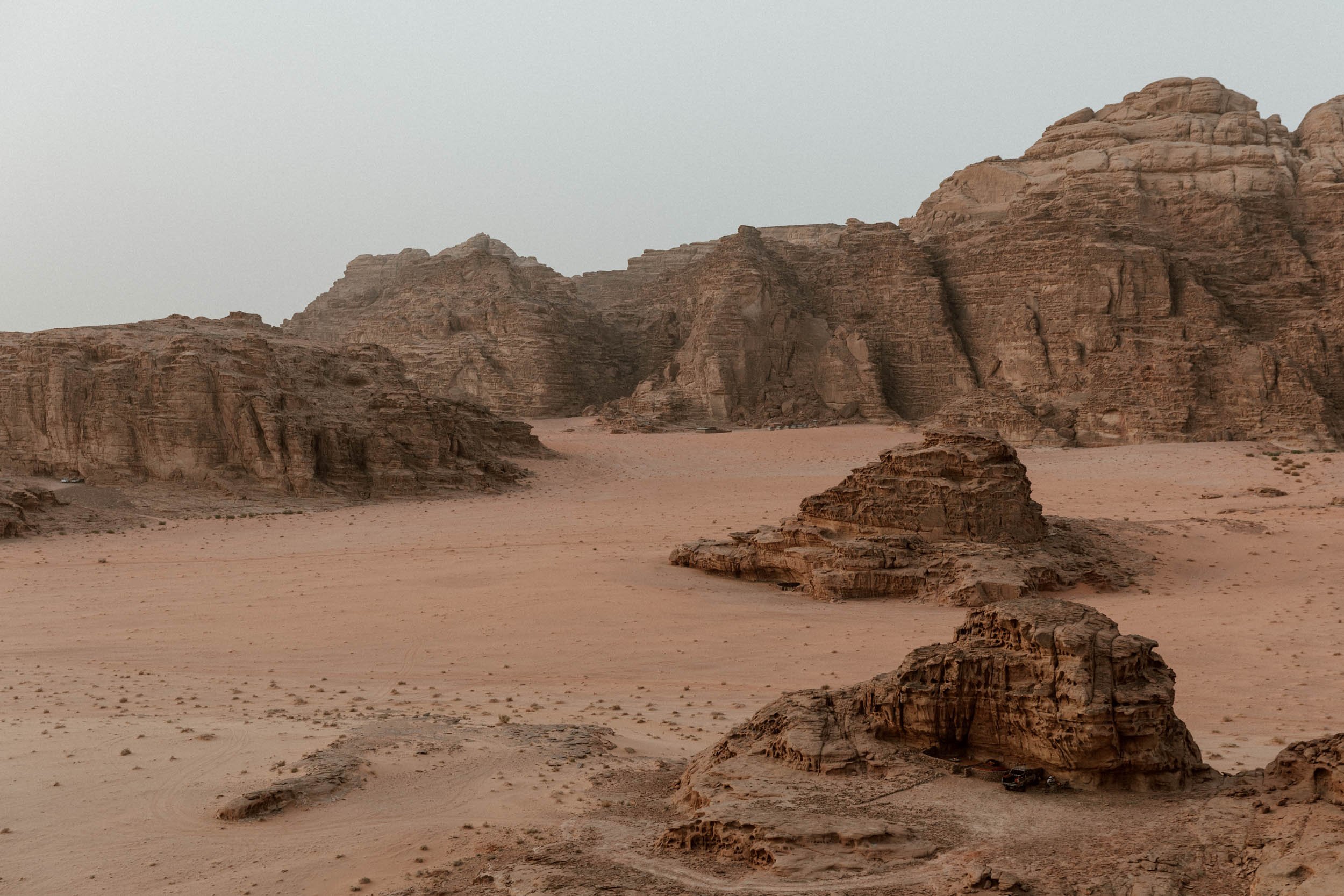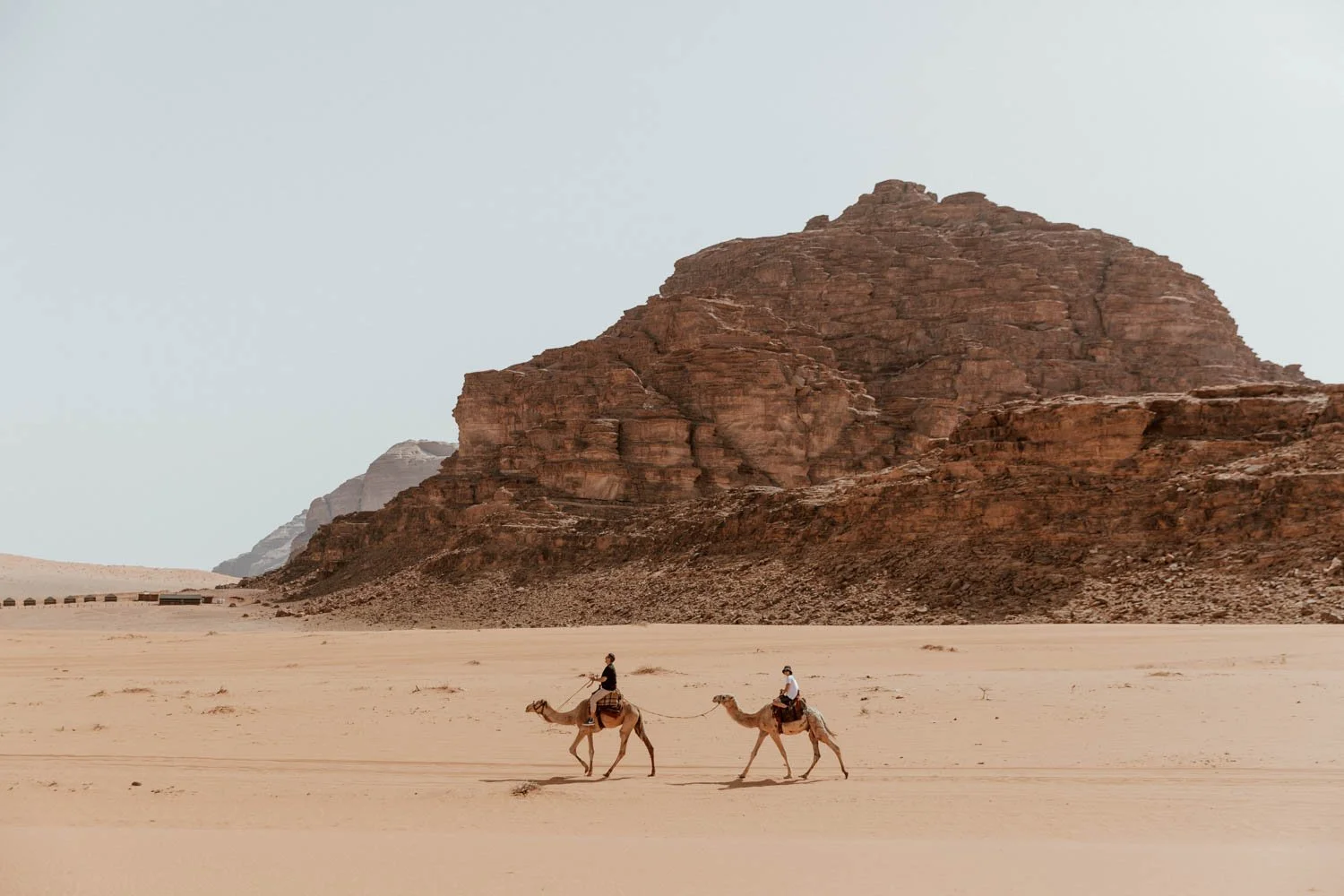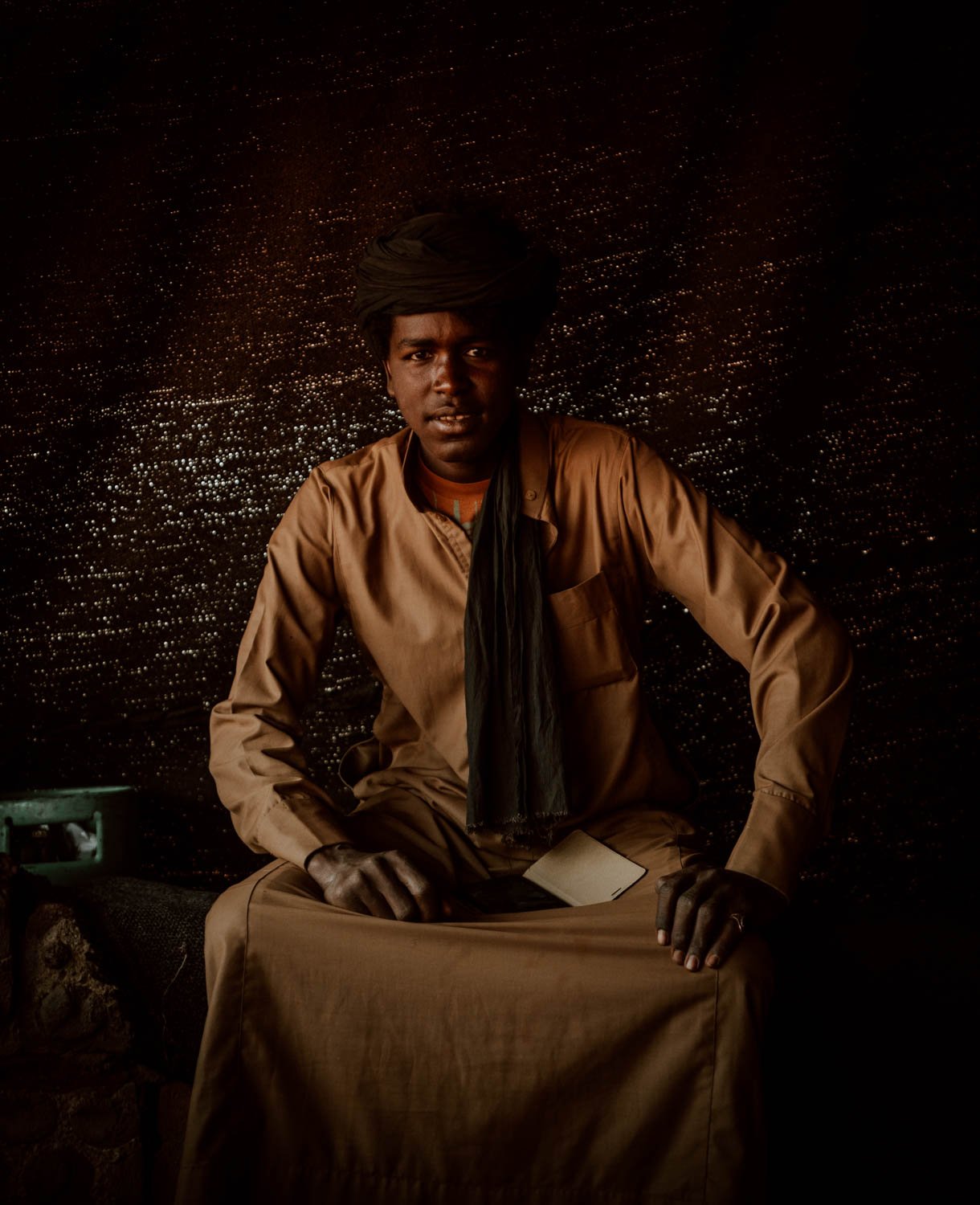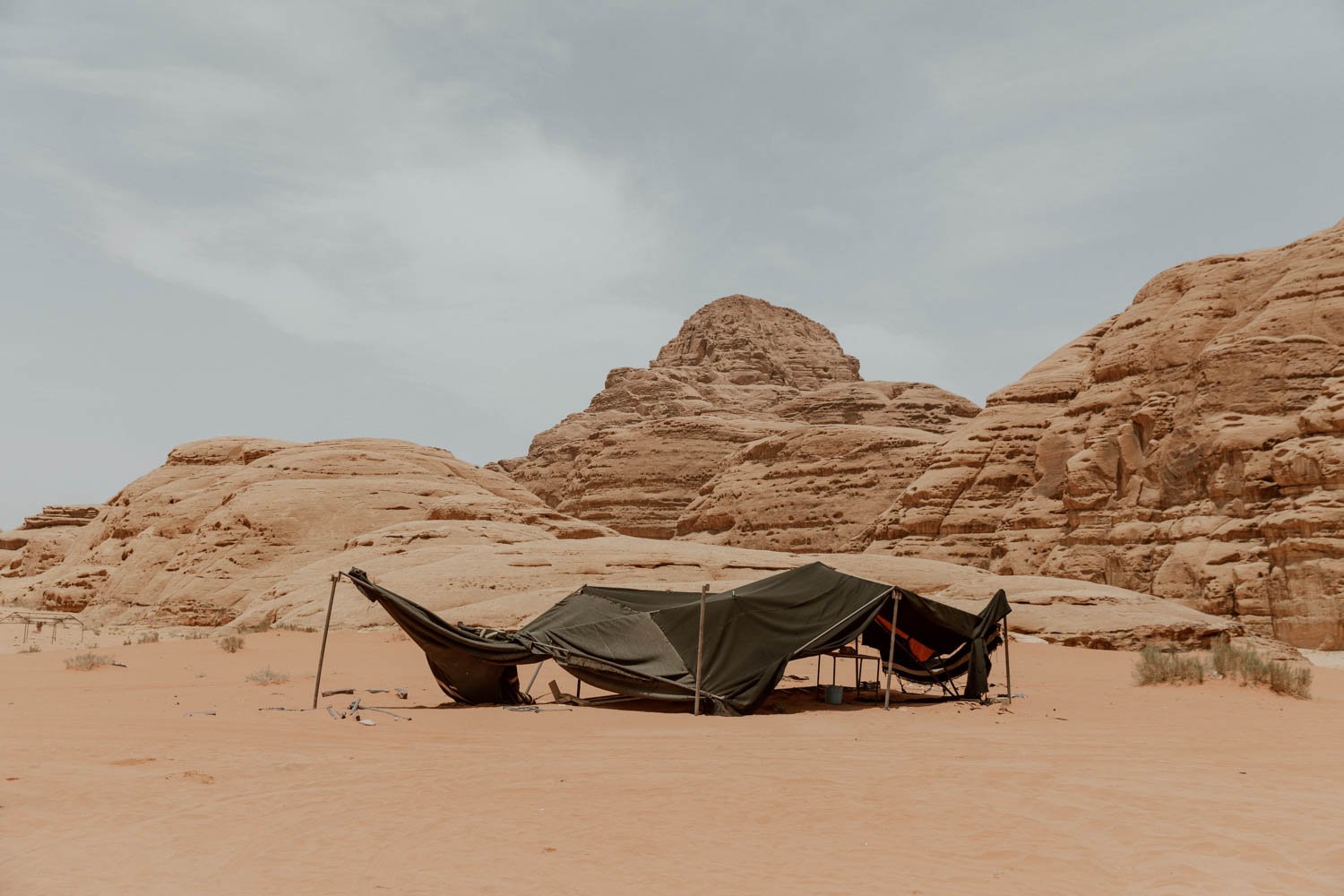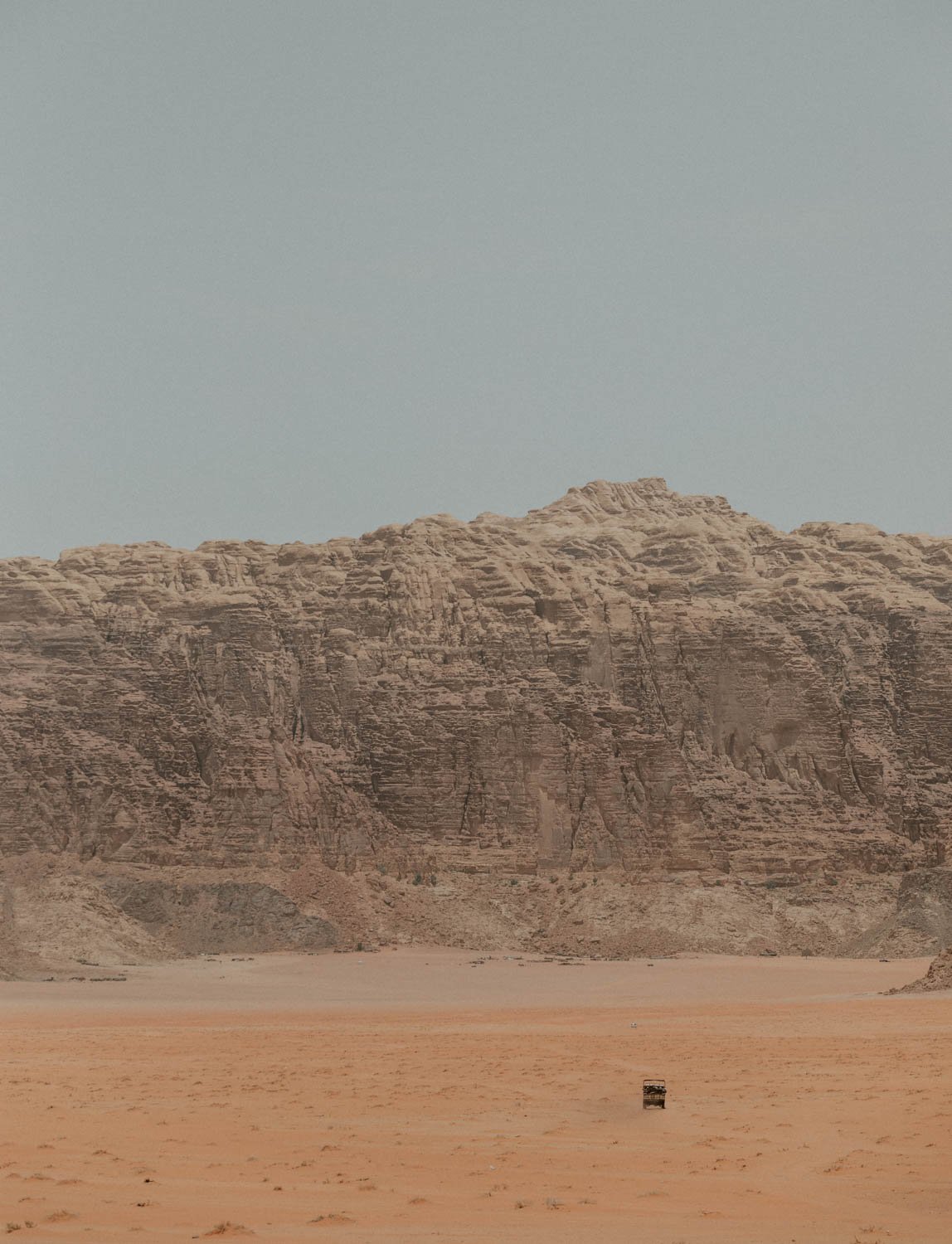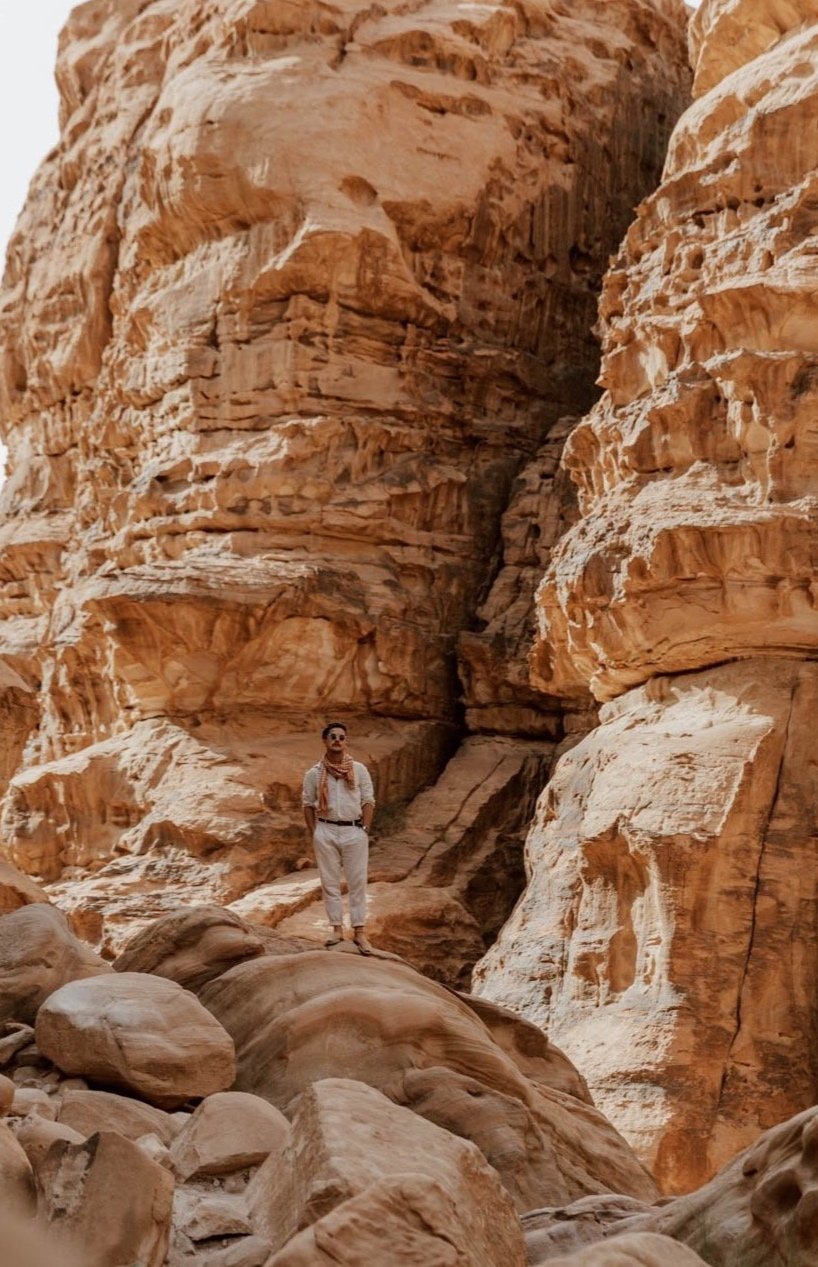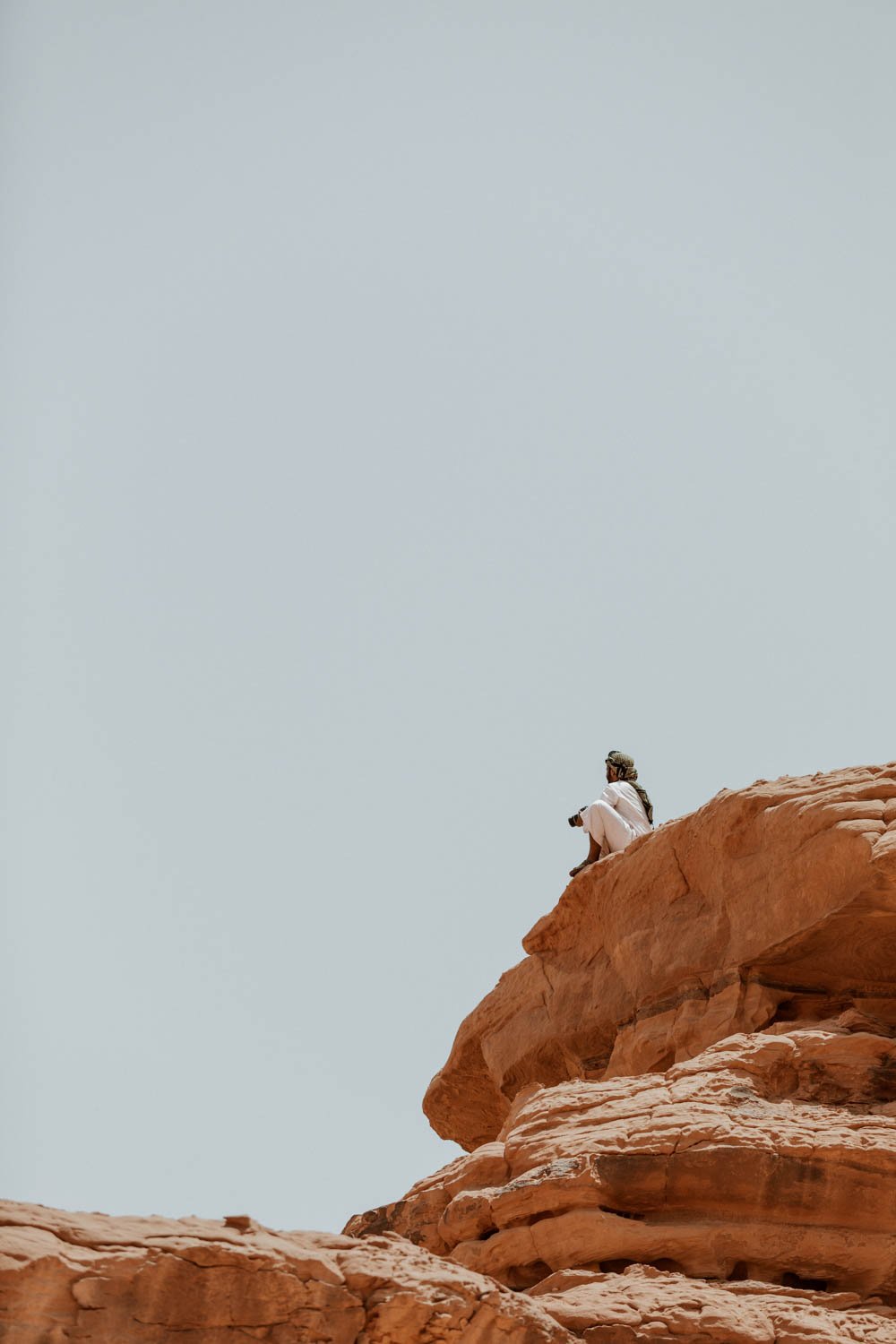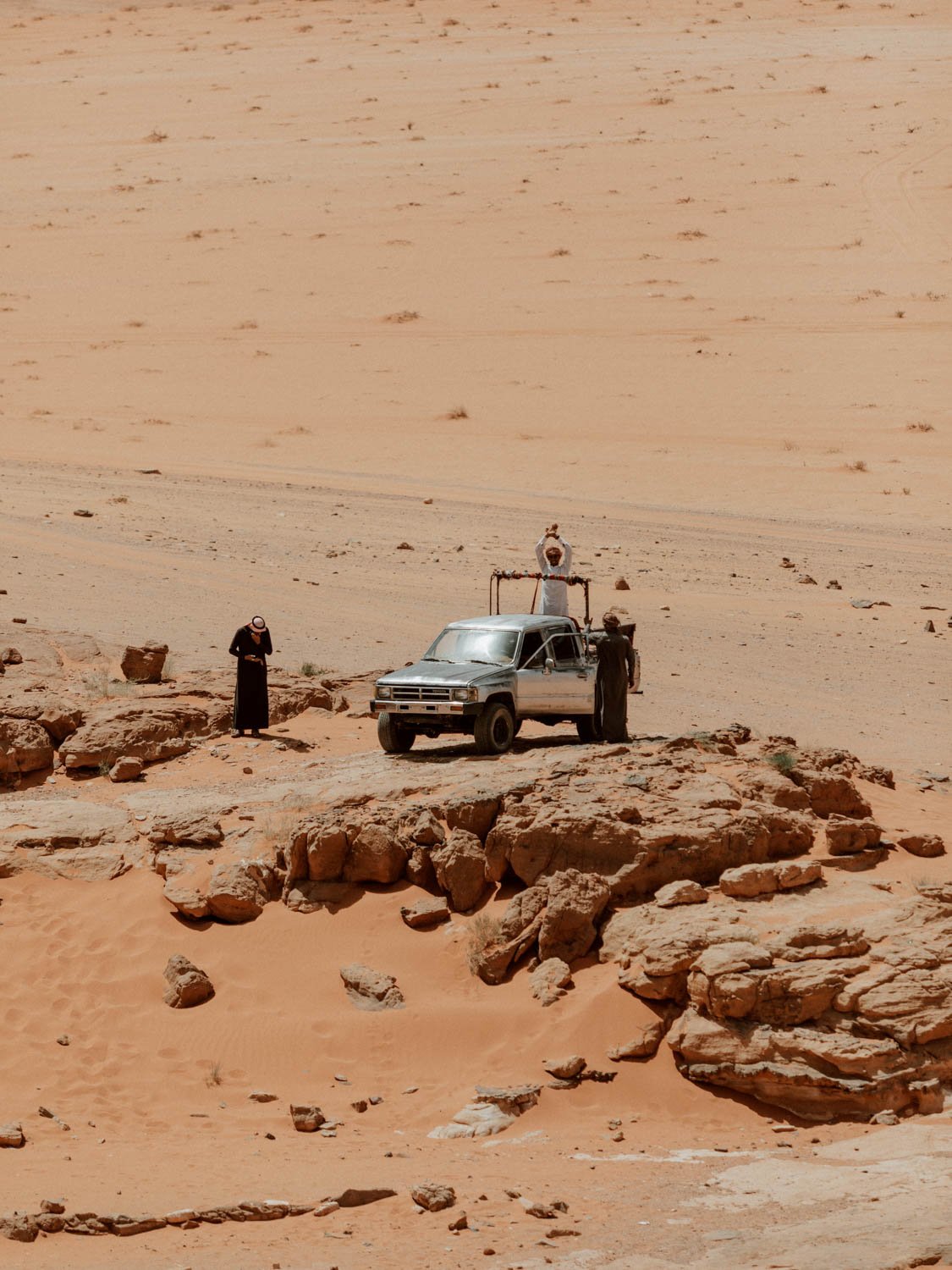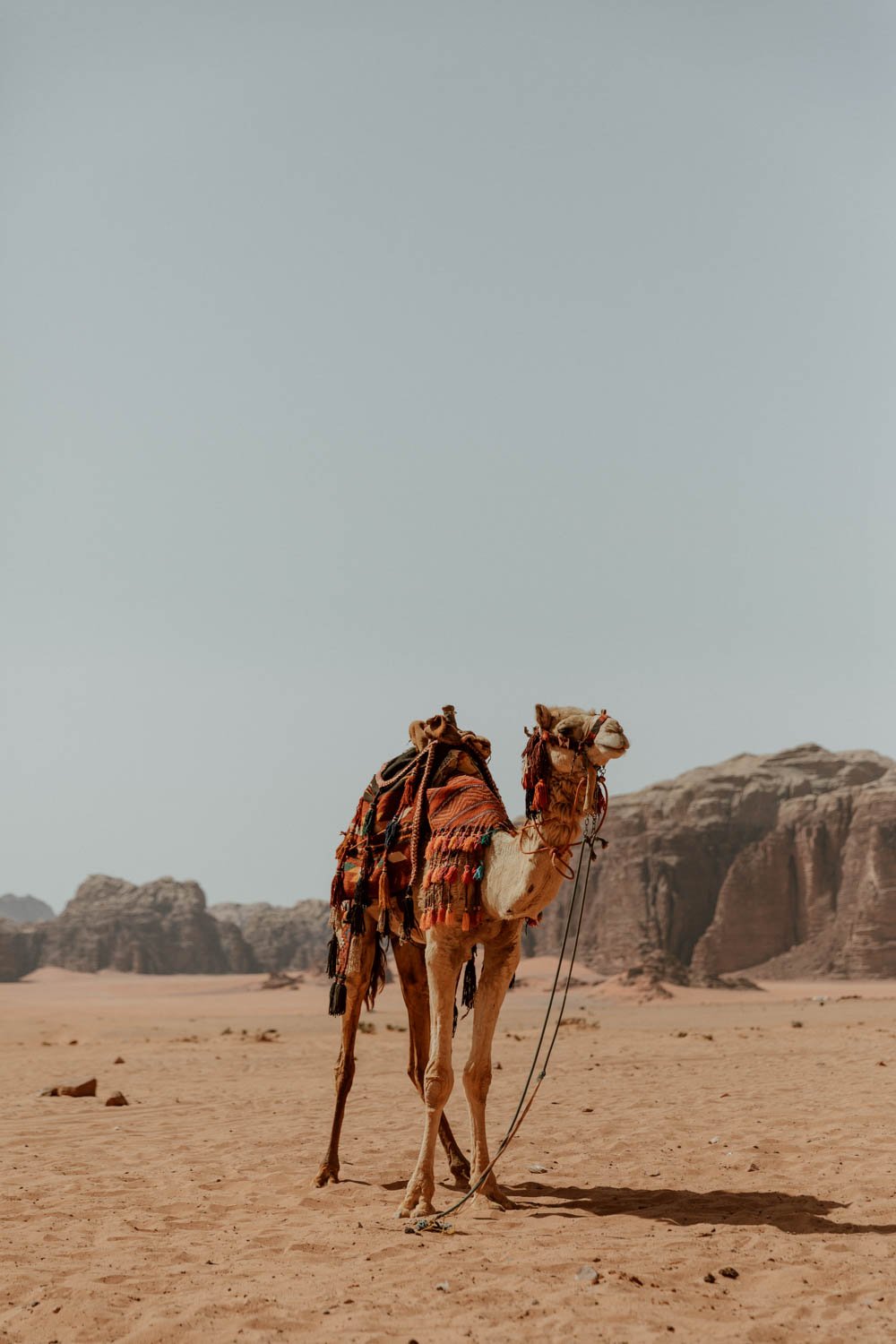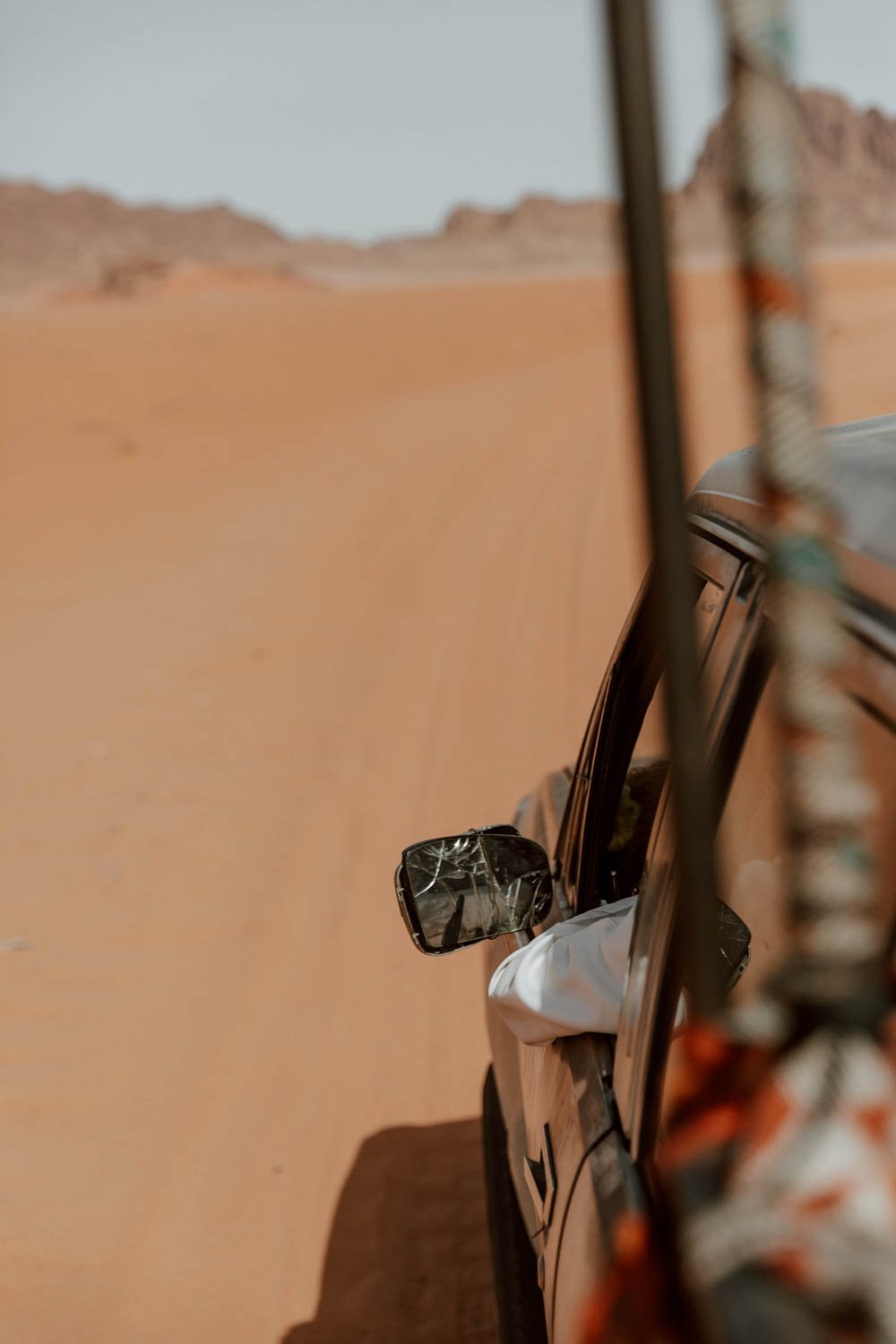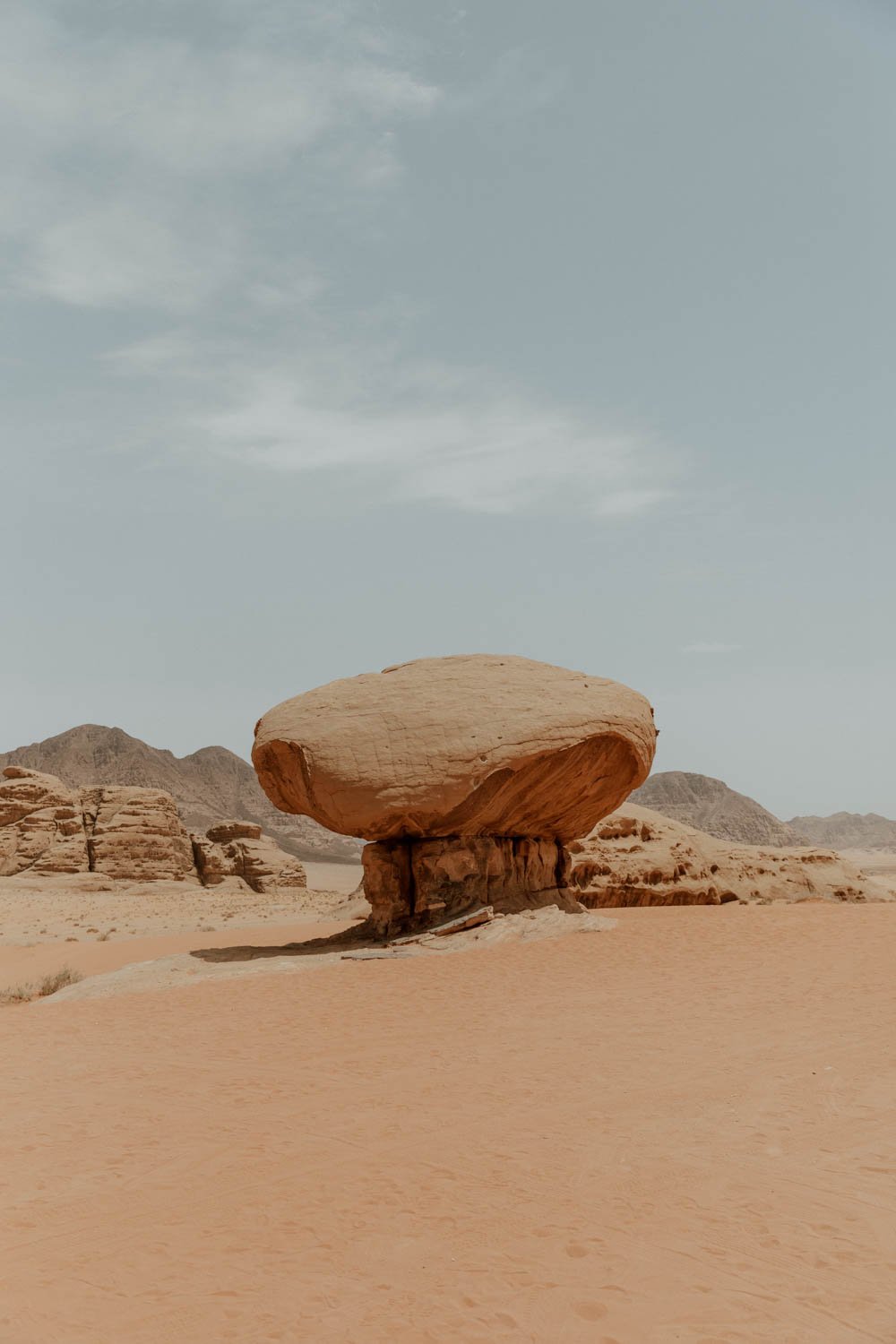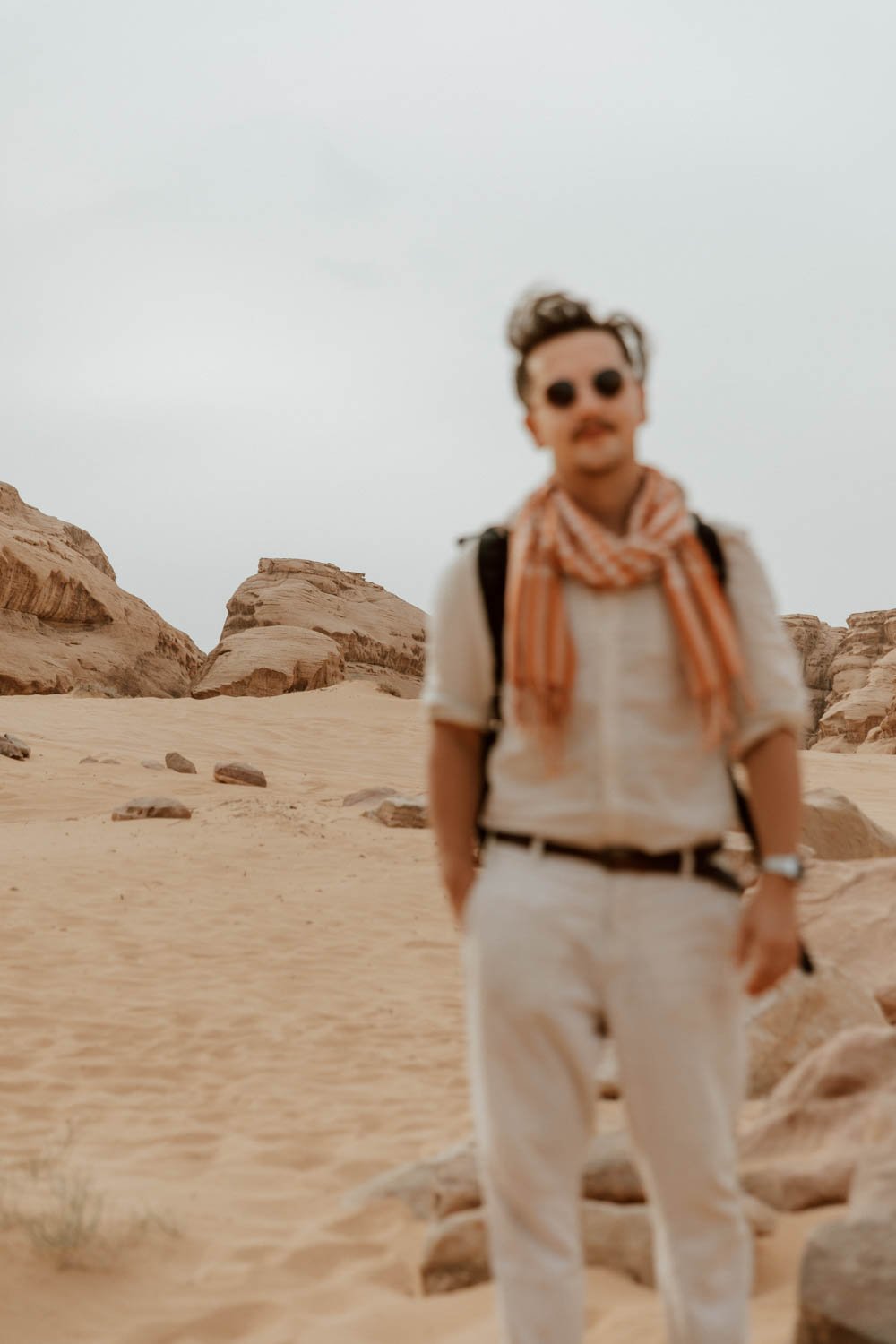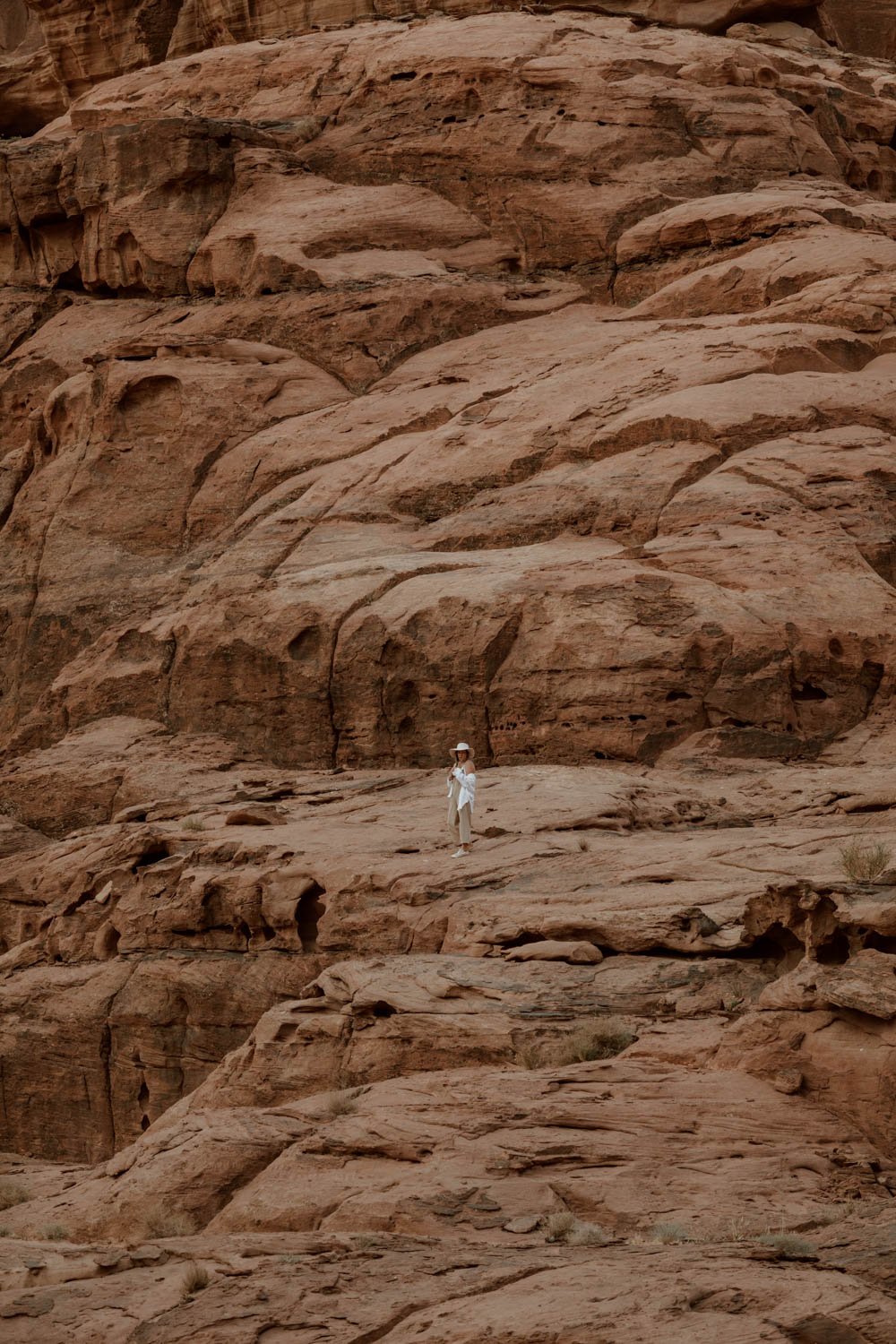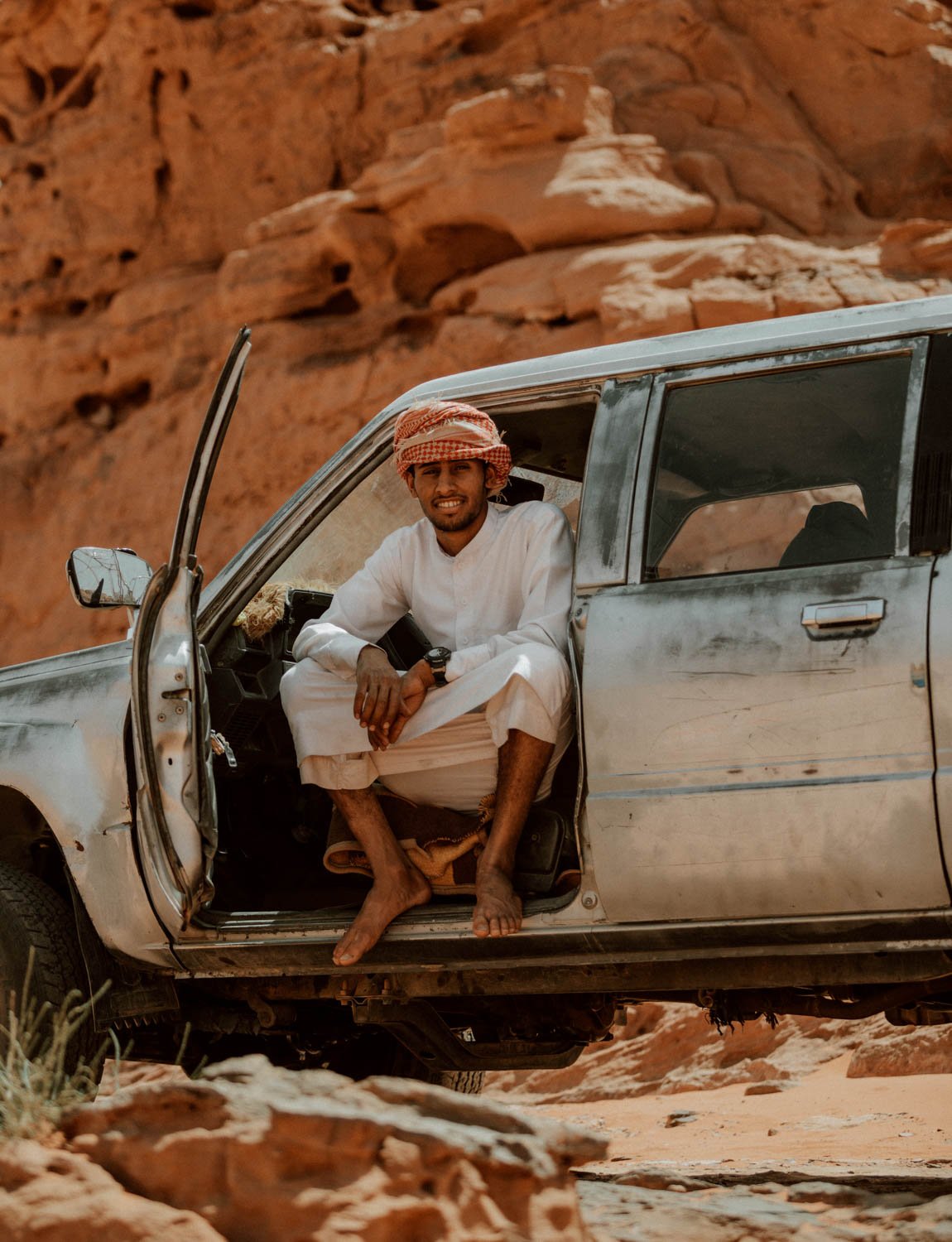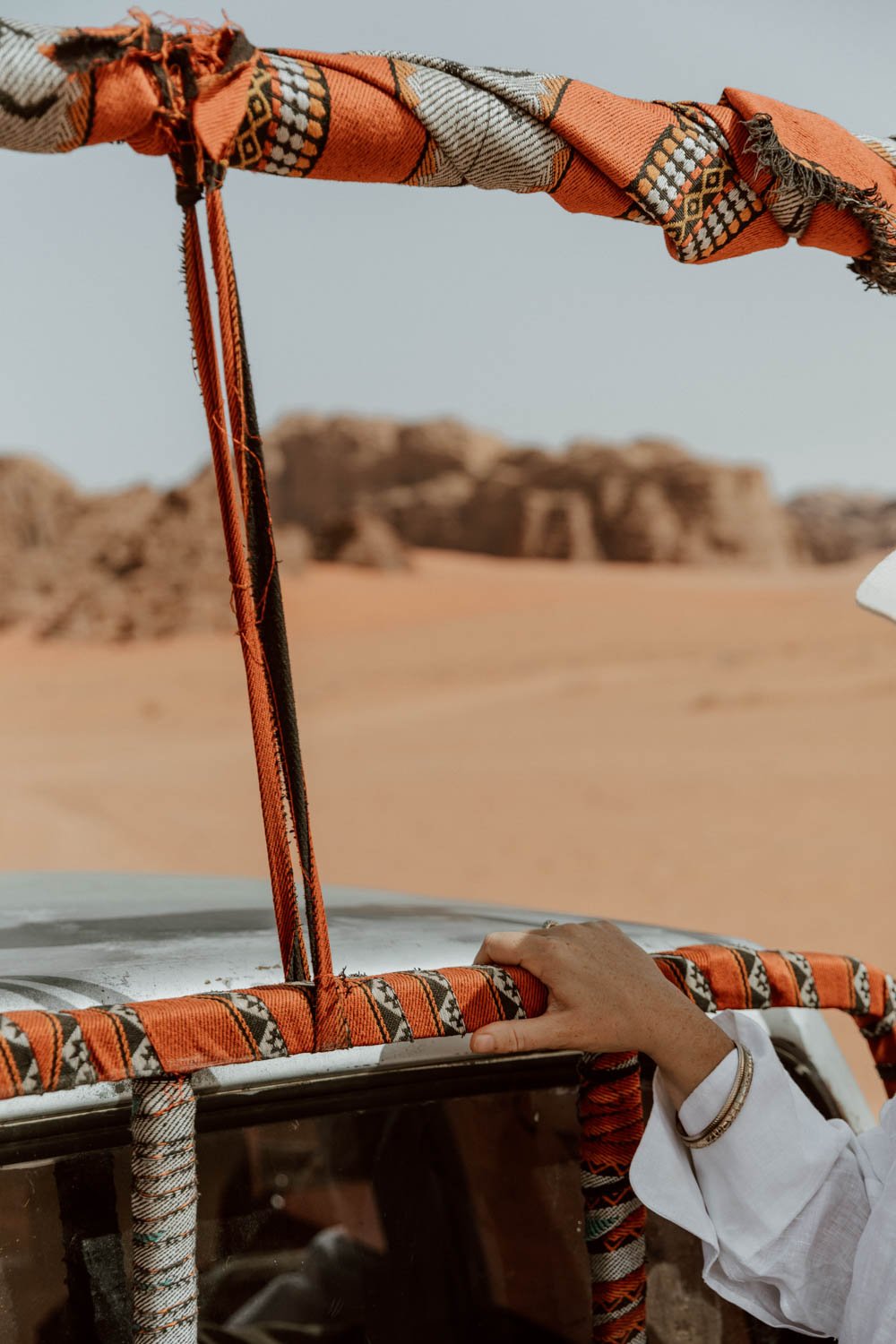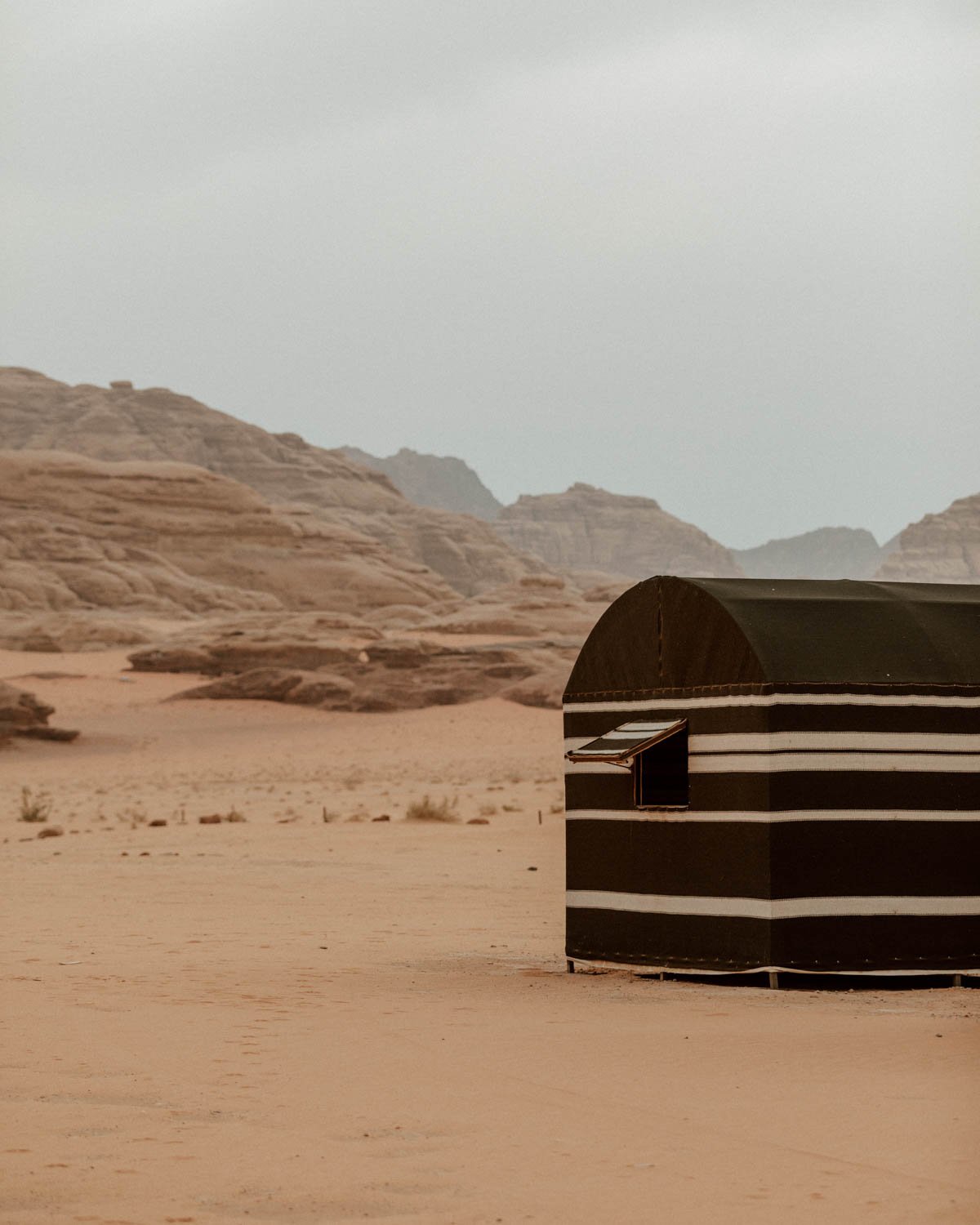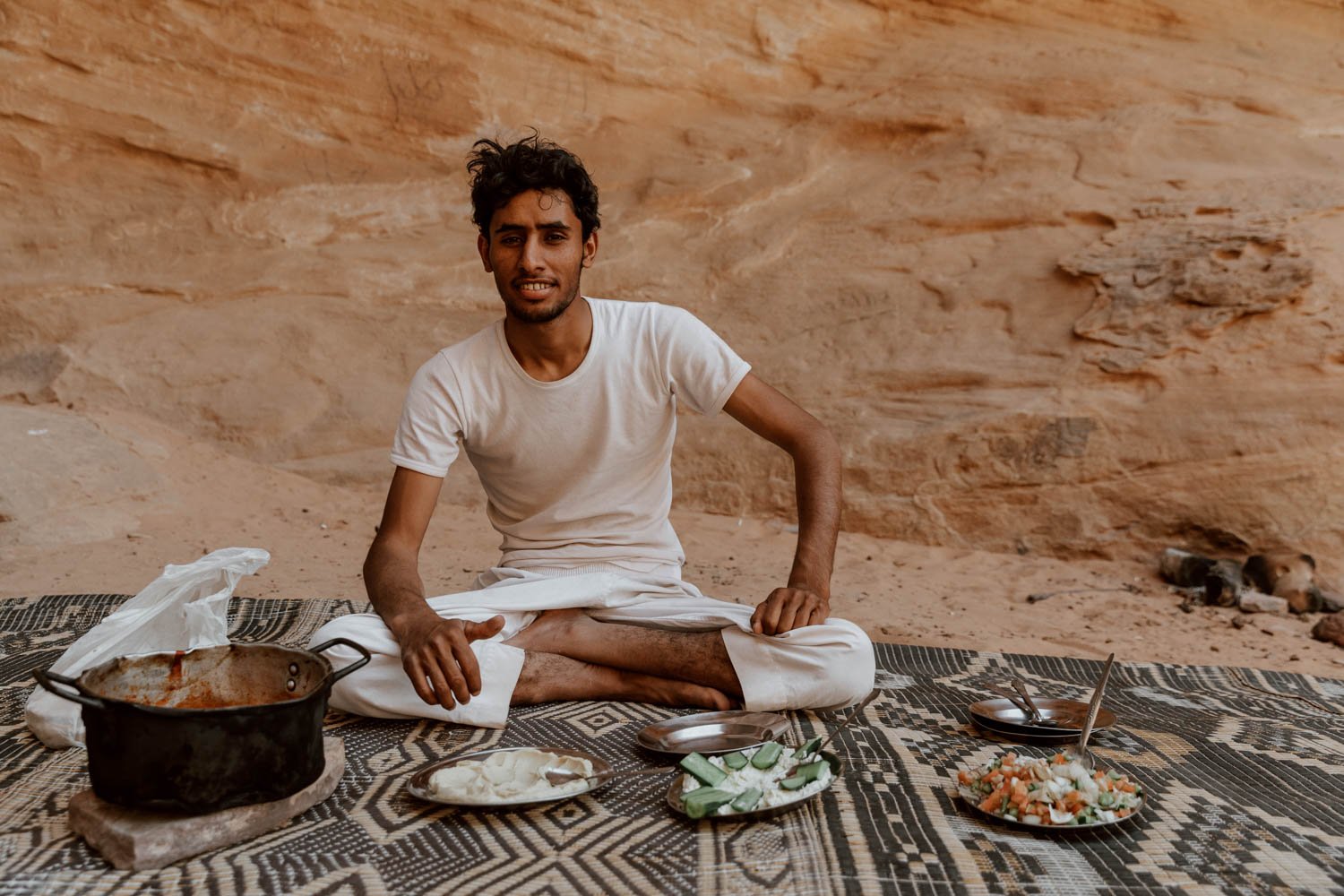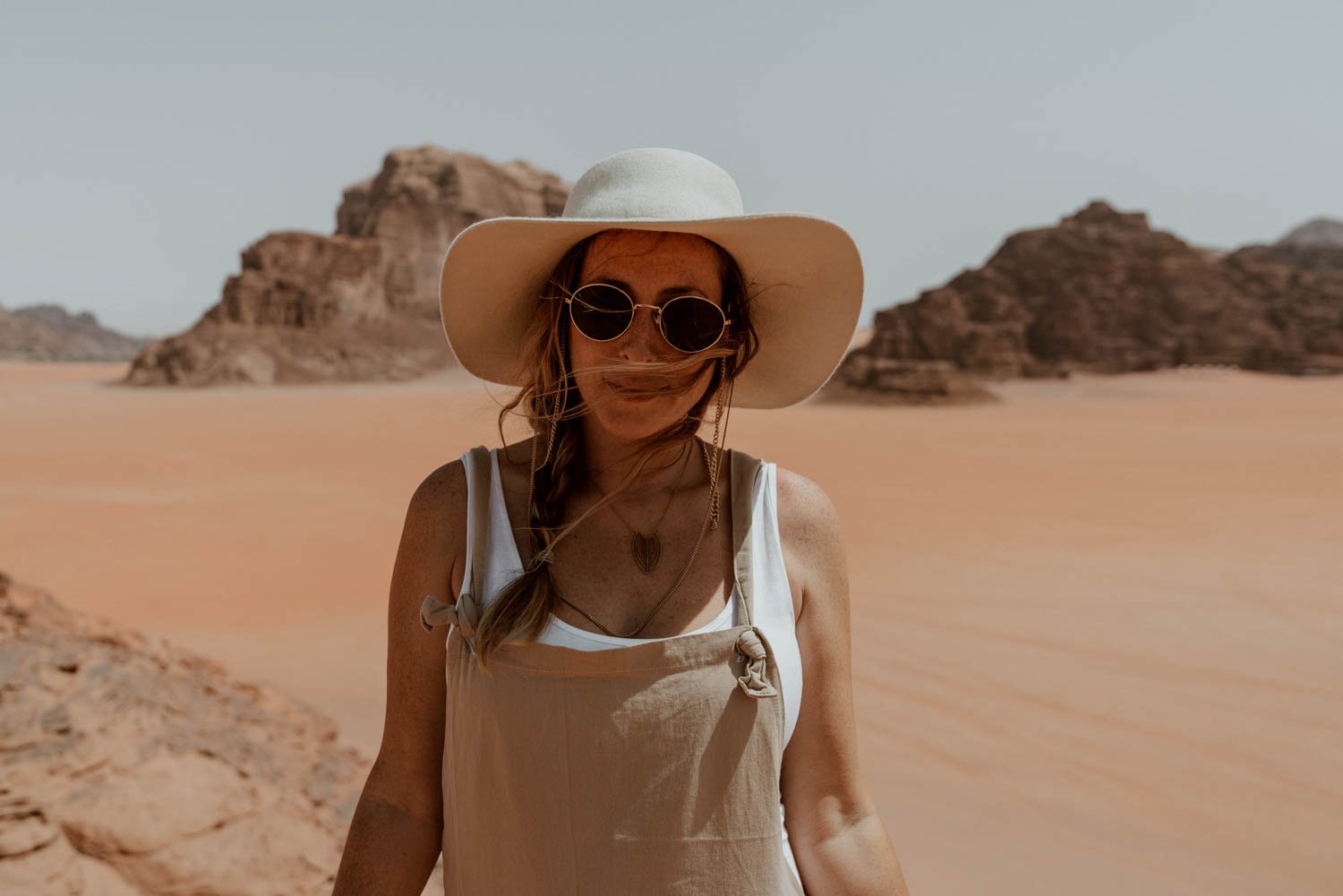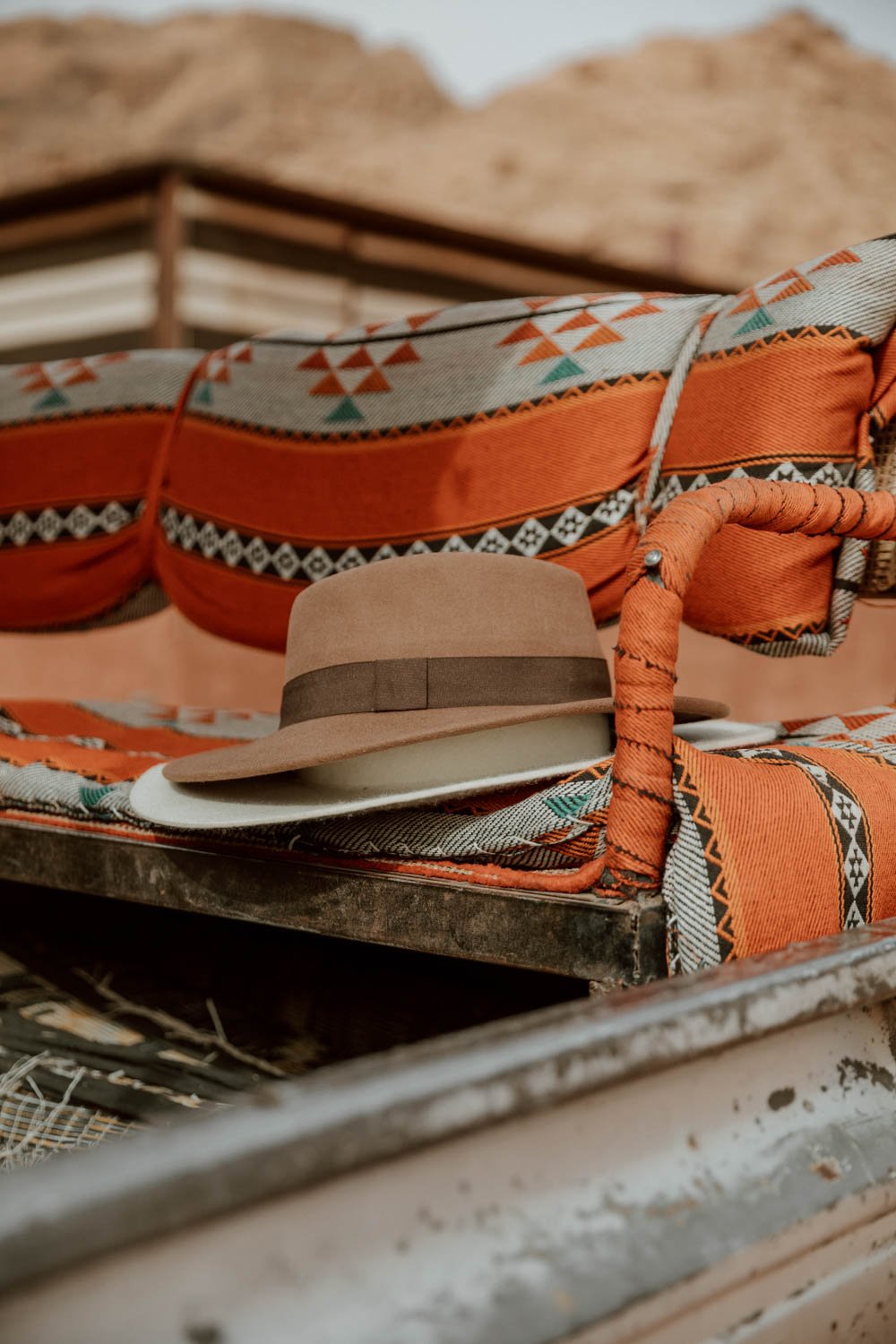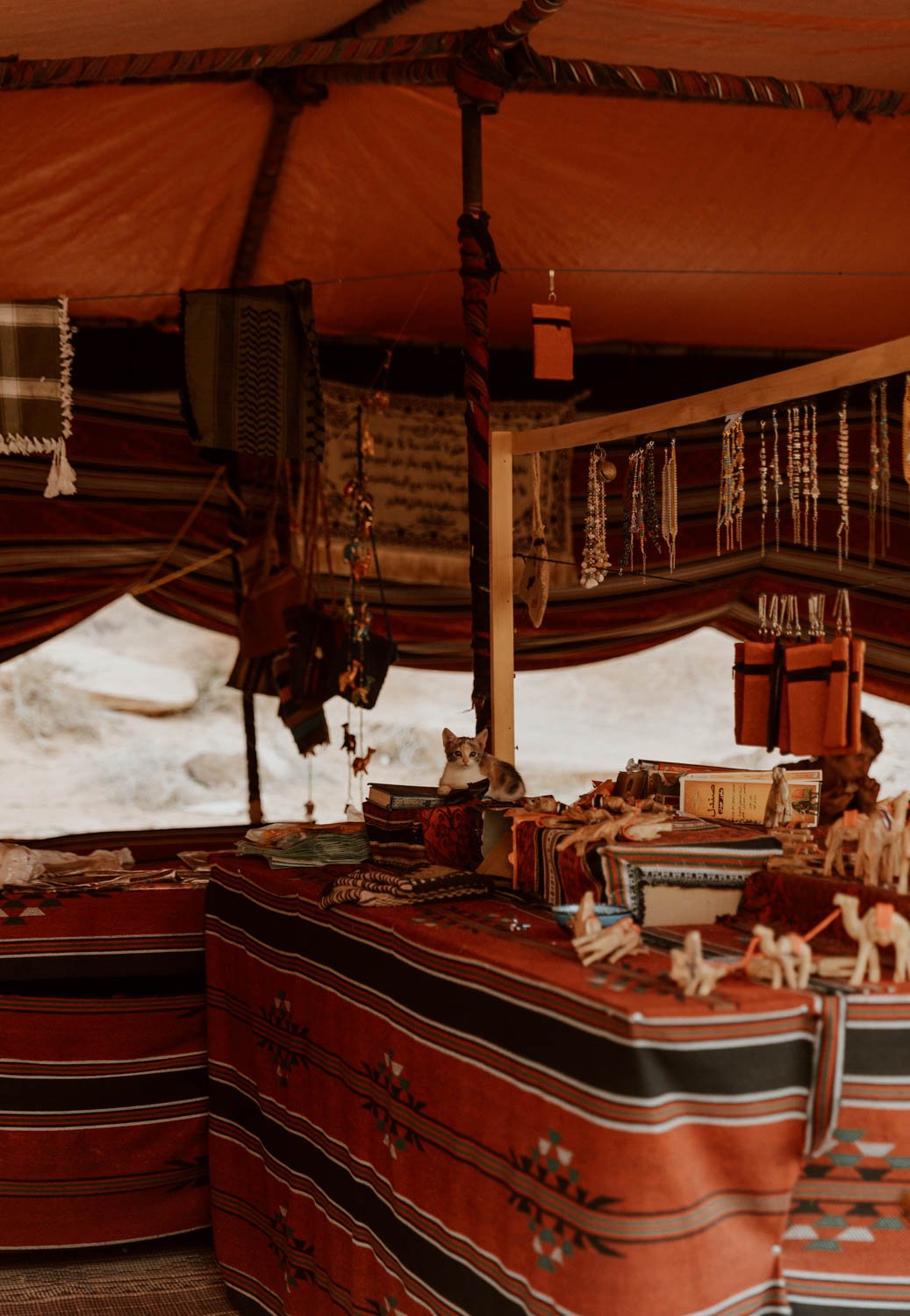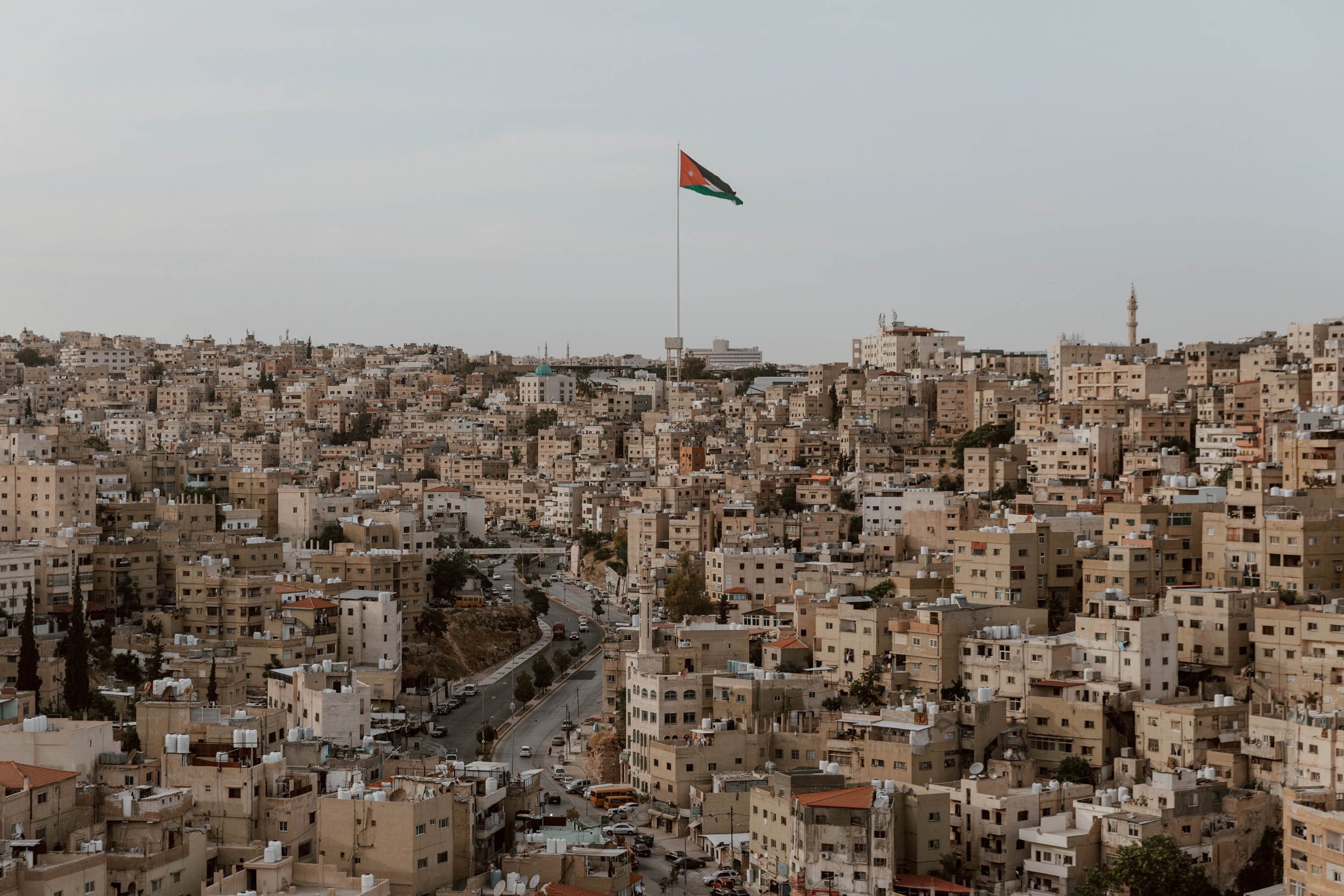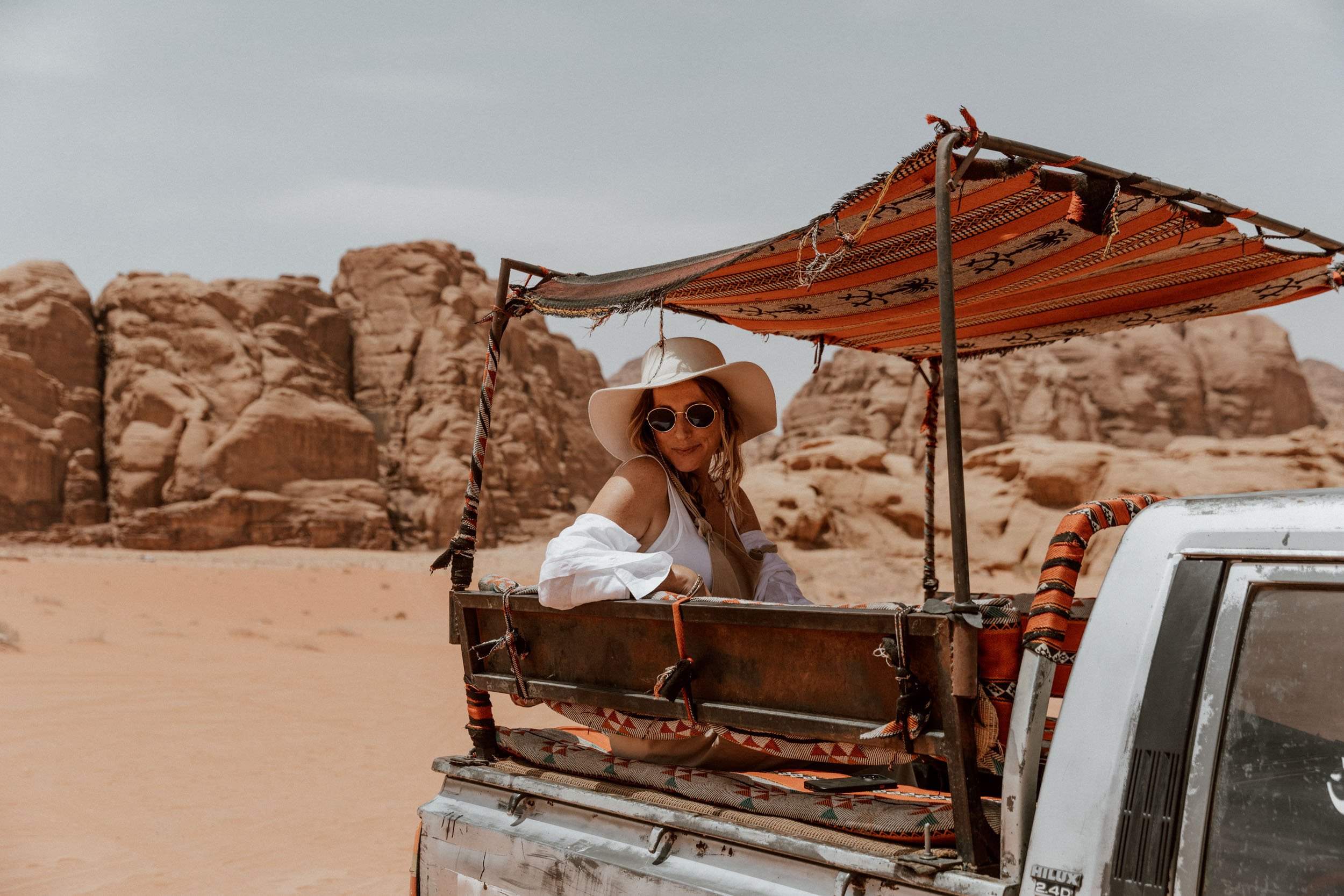Planning to visit Wadi Rum? This is what you really need to know.
Updated October 2023
From the moment our Bedouin guide’s battered white Toyota pick-up truck left the tarmac behind and trundled deep into the vast rust-red desert, we knew an unforgettable experience lay ahead.
Across two weeks in Jordan, Wadi Rum was the place that left us most awestruck.
One of the world’s most spectacular desert landscapes, stretching forever ahead and dotted with sandstone mountains, monoliths, canyons and secrets carried by the wind, the ‘Valley of the Moon’ is somewhere that no traveller in Jordan should miss.
However, what’s the best way for your travel style?
Before we visited on our two-week road trip in Jordan, working out how best to experience Wadi Rum was the most challenging part of our itinerary planning and research. There was a lot of information out there, but it felt like a few essential pieces of the jigsaw puzzle were missing. There were also a bewilderingly high number of desert camps and tours to go through, and a limit on how much time we could feasibly spend looking through them all.
As we had a good amount of time in Jordan, we decided to spend two nights in the desert so we could enjoy it slowly, make our own impressions and mistakes, and then pass on the necessary practical tips, context and insight for your own planning.
With this post, we want to help you have the best possible adventure in Wadi Rum - whether it’s an independent day trip, overnight stay, or tour from elsewhere in Jordan
From the basics on logistics and weather to how to pick the best desert camp for your travel style, what a jeep tour really involves, how long you actually need in the desert, what to bring (and leave behind), whether to visit Petra first, tour recommendations, and tips to travel better, these are 23 essential things to know before you visit Wadi Rum, Jordan.
In terms of inspiration, we hope the photos and the landscape speak for themselves.
the wadi rum essentials
What / A protected 720 km2 desert area with landscapes that are often compared to Mars
Where / In south Jordan, 2 hours from Petra
Entry / 5JD or free with Jordan Pass
How / Explore by jeep tour, camel or hikes - day trips possible, but overnight is best
Tour / If you’re short on time this day tour is very popular
Stay / Wadi Rum Backpacker Camp is ideal for those on a budget, mid-range travellers should take a look at Milky Way Bedouin Camp but for a truly luxury experience consider Wadi Rum UFO Luxotel
Book / Also possible to book an overnight, desert adventure combo package like this one
What On Earth Is Wadi Rum?
The ‘Wadi Rum Protected Area’ is a designated nature reserve and UNESCO World Heritage site.
A cavernous ocean of ochre sand, it forms the largest ‘wadi’ - dry valley - in Jordan, and is about the same size as New York city. Except the smattering of camps and tents to sip hot, sweet tea in the shade, there are few to no buildings or permanent settlements.
There are no roads, and the only waymarkers are the changing hues of the dunes and the contours of mammoth sandstone sculptures; works of art shaped and carved by wind, sand, salt, and the earth’s subtle shifts.
It is a remarkable, untouched, awe-inspiring place to behold.
IT’S The TRIBAL HOME oF BEDOUINS
As barren and inhospitable as the desert may seem, thousands of preserved rock carvings and inscriptions in gorges and canyons here point to ‘12,000 years of human occupation’.
Today though, Wadi Rum is only home to several Bedouin tribes.
Meaning ‘desert dweller’ in Arabic (badawī), these nomadic people have historically roamed the desert regions of the Middle East and North Africa. Their peripatetic way of life was significantly impinged with the creation of new borders and countries in the 20th century, as well as encroaching modernisation and industrialisation, but traditions and identity have remained strong.
The majority of Wadi Rum’s Bedouin, particularly the younger generations, have chosen to stay permanently in the small concrete village at the entrance to the desert, although there remain some roaming and living in the traditional manner. With historic rights to parts of the land, they own and operate the majority of the desert camps, and work as drivers, guides, cooks, camp managers, as well as various other trades associated with the tourism economy which underpins the majority of incomes here.
Bedouin hospitality and the local community therefore play a significant role for the traveller visiting Wadi Rum today, and your time here offers an excellent opportunity for cross-cultural connection around the evening fire, when sharing food at camp, or as you spend time with your driver-guide.
Life on Mars
Wadi Rum may already feel oddly familiar to some of you though, as the desert has been a much-used filming location for Hollywood classics and blockbusters.
The 1962 classic ‘Lawrence of Arabia’ started it all, inspired by its real-life protagonist’s connections with Jordan*, and more recent movies filmed here include The Mummy, Star Wars: Rogue On AND Star Wars: Rise of Skywalker, Theeb, Promotheus, the live-action Aladdin, and Dune.
If you couldn’t tell already, people like to film here when they need a stand-in for strange, unwelcoming planets.
Due to these otherworldly landscapes and its famous reddish-orange hues, Wadi Rum is also the filmmakers’ favourite choice of a closer-to-home alternative to Mars; indeed, if there’s a movie with ‘Mars’ in the title, chances are some of it was shot here!
Titles include The Last Days on Mars (2013), Red Planet (2000), Mission to Mars (2000), and the desert was also the main filming location Matt Damon’s ‘The Martian’ (take a look at the trailer here).
If you’ve got room in the suitcase, might as well pack a space suit for some photo opps…
* The remarkable life and works of T.E. Lawrence (the British army officer better known as Lawrence of Arabia) are worth taking stock of, and he is often credited with making Wadi Rum an attraction amongst western tourists. Indeed, several landmarks in the desert are named after him and he is thought to have spent time here during his expedition to support the Great Arab Revolt; however, the extent of how much time and where he actually spent hiding out in Wadi Rum is quite open to debate.
Where Is Wadi Rum & How To Get There
It’s in the southeast corner of Jordan, close to the border with Saudi Arabia, and the only way for tourists to arrive at the entrance to the Wadi Rum desert is via road.
Find it here on Google Maps.
Typical drive times from other popular destinations in Jordan are:
Aqaba // 1 hour, 56 km
Petra (Wadi Musa) // 2 hours, 107 km
Madaba // 4 hours, 296 km
Amman // 4 hours, 313 km
Dead Sea // 4.5 hours, 330 km
When planning your Jordan itinerary, the southern city of Aqaba and Petra (Wadi Musa) are the two most sensible destinations to visit before or after Wadi Rum, or convenient bases for an easy Wadi Rum day trip (especially if you don't have a rental car).
We've shared advice on transport, taxis, and tours from both in these short explainer posts:
· How To Get From Petra to Wadi Rum
· How To Get From Aqaba to Wadi Rum
If you do have a rental car though, your options open up slightly. Given the north-south layout of Jordan's most visited places, a very popular option is to drive straight down the Desert or King's Highway from the capital city of Amman, the city of Madaba, or the Dead Sea resorts to one of Wadi Rum or Petra; as Petra is a couple of hours closer to all of them though, that is going to make the most sense as your first stop. However, if you'd prefer to flip them around and do Petra on your way back north, there wouldn't really be a downside.
Before deciding or renting anything though, we highly recommend reading our Essential Guide To Driving in Jordan.
THe VIllage & Visitor Centre LOGISTICS
Though most of your time in Wadi Rum will be spent within the wide open empty desert, it's really important to understand two key locations you'll encounter on arrival and before the roads disappear into a sea of sand.
Wadi Rum Visitor Centre | From the signposted turn-off at the Wadi Rum intersection on the Desert Highway (here on Google Maps), it's a stunning 22kms along a narrow road to the modern Wadi Rum Visitor Centre Complex. If you're on a tour, make sure to pay attention out the windows, and don't rush this section if you're driving.
All visitors must stop at this Centre in order to register with the officials, show their Jordan Pass and/or purchase tickets. You also need to know details of your car, tour, and accommodation (if you're with a tour guide, they may take care of this on your behalf).
Those of you with a rental car may wish to park up for a few minutes at the adjacent car park in order to do this (Andrew just pulled to the side of the police checkpoint and walked to the office though).
Note that if you've arrived without pre-arranging any jeep tours or accommodation, this is also the best place to set something up spontaneously.
Find the Centre here on Google Maps. Opening hours are 7am - 10pm.
Wadi Rum Village | It's a further 7 kms from the visitor centre to the breezeblock Wadi Rum village (maps). The gateway to the desert, this is now the permanent base for most of the Bedouin community involved in Wadi Rum's tourism trade, and it has a few cafes and shops for basics (pricer than elsewhere) alongside dozens of battered Toyotas, resting camels, the odd resting camel being driven in the back of a battered Toyota, and (exclusively it seems) men and young boys hanging out.
This isn’t somewhere you'll spend much time, but for those with a rental car, it’s where you’ll park up and meet with your camp / guide.
It's also the departure point for taxis and the daily bus to Petra.
After the village, the tarmac ends and it's just sand, desert, and wilderness: it's this area that is the true 'Wadi Rum Desert' that you'll experience with your jeep tour and sleep in at camp.
Top Tip // Tours arranged without an overnight stay in a camp (or all-inlcusive overnight stays with companies like Get Your Guide or Viator) vary in their pick-up location depending upon which tour you book - be sure to confirm where you’ll meet the tour guide prior to arriving.
YOU NEED TO Leave Your Car Behind
Unless otherwise advised by your camp or tour, if you're arriving with a rental car or private taxi, you will park and meet with your guide or accommodation’s driver in the Wadi Rum Rest Stop (maps).
The Rest Stop is in the village, and it’s really just a car park and meeting point. Parking is free and it's safe to leave your vehicle and main luggage here for as long as you are in the desert, but we recommend taking valuables with you and storing anything worthwhile out of sight. And just double-check the car’s locked and windows closed before you head out to the dunes!
From here, your camp or tour is responsible for transporting you in and out of the desert proper.
It's not permitted for a visitor to drive in and around Wadi Rum with their own vehicle unless you've got a suitable 4x4 and permission. A 4x4 permit is available at the Visitor Centre at 25 JD for owned vehicles, 35 JD for rentals, but we would strongly advise against doing this if you have a rental 4x4; it's likely against the Ts&Cs, there are no roads, and getting lost and stuck in the sand is inevitable.
If staying in one of the super-luxurious, be aware that some offer private, secure parking elsewhere in the village, and you will be advised of this after making your booking.
Top tip // We rarely go direct when hiring cars, instead preferring to use two popular rental aggregators to compare costs and find the best deal. The two companies we use are AutoEurope and RentalCars - both of which we have had excellent experiences with and saved substantial amounts over going direct (never entirely certain why, but it’s a common outcome when we do a comparison).
Find out more and reduce your costs + stress with 17 Things To Know Before Driving in Jordan.
Best Time Of Year To Visit Wadi Rum & Desert Seasons
Wadi Rum is a year-round destination, but seasons impact a desert more than you may necessarily assume and, given Jordan's increasing popularity as a travel destination, there are defined times of year when the crowds from day trips, tours, and overnights will be notably larger.
The most crowded months will be September to November and February to May, coinciding with high season in Jordan. The warm to hot weather at these times is ideal, but in our experience there can be a few too many people at popular stops on the standard jeep tour itineraries (more on this later).
In July and August, the days get longer and crowds thin out, but it's stiflingly hot in the desert and across southern Jordan (up to 40°c). Unless you’re used to super hot temperatures, we’d recommend avoiding these months.
December to February sees lower demand but chillier nights and more inhospitable weather conditions (even snow!). Because of this fewer camps may be in operation, but prices may be reduced. If visiting in this season, you really need to pay attention to what you pack for Wadi Rum - see final section of this guide.
Whenever you visit, note that the difference between midday and midnight temperatures can be quite stark, so it’s always best to bring a layer no matter the season. Overcast weather is also a possibility, so spectacular sunsets cannot always be guaranteed.
As we explain further in 23 Things To Know Before You Visit Jordan, we think it’s best not to visit Wadi Rum when Ramadan falls.
Finally, and we speak from personal experience here, there’s an annual marathon in Wadi Rum and sometimes an ultra (crazy, right?). Usually held in May, we fortunately found out about this a few days before we arrived, so were able to change our dates last minute (aside from camps being full with runners, we didn’t think large groups of runners would add much to our photos!)
You Need Tickets for Wadi RuM
Most of you will actually have free entry with your Jordan Pass. The government tourism ticket bundles in over 40 attractions in Jordan, including Petra and Wadi Rum, and waives visa fees too, meaning it's guaranteed to save money for the majority of travellers.
You do however have to purchase it before you arrive in Jordan.
Find out more about the pass, its money-saving benefits, and whether you should buy it in our short explainer review of the Jordan Pass.
If you don't have the Pass, thankfully the standard tickets are very cheap at 5JD for adults, and you simply purchase them in person at the small official office in the visitor centre (best to bring cash). Tickets can and should only be purchased from this office, so don't pay anyone else at the visitor centre who offers or asks.
Under-12s receive free entry, and we should also note here that Wadi Rum is very much a suitable and enjoyable activity for families!
Even if you have the Jordan Pass, note that you still need to register and show it at the visitor centre before travelling onward to the village.
Do not try to enter Wadi Rum on your own, without a guide or without a tour.
Things To Do in Wadi Rum
Ok, so what exactly is there to do in Wadi Rum?
The epic, otherworldly landscapes are the main draw, and experiences and activities revolve around immersing you within them.
The two most popular things to do in Wadi Rum are jeep tours and desert camp stays, and anyone staying overnight should do both.
Jeep Tours
Usually with a Bedouin driver and a converted Toyota 4x4 pick-up truck, tours vary in length (from two hours to a seven to nine hour ‘full day’) and shuttle you around several landmarks, viewpoints, rock bridges and formations, hospitality tents, and canyons; the experience of driving around and what you see from the jeep is as much a part of it as the places and a photo spots you’ll stop at.
Jeep tours can be private or shared, and we’ve shared more details on them later in this post.
Desert Camps
Mostly owned and operated by local Bedouins and situated in the middle of nowhere in the desert, staying in a Wadi Rum desert camp will add a whole new dimension to your experience. Aside from the setting, the chance to hear stories passed down through the generations, share food around the fire, and listen to traditional music performed under the starlight marks it out as perhaps the most memorable night you’ll have in Jordan since Dane Bowers.
Desert camps range from basic goat-skin structures to luxury glamping pods, with these transparent bubble domes becoming very Insta-famous the last few years.
We actually spent our first night wild camping in a cave, and we talk more about that in this post: How To Choose You Wadi Rum Camp (published soon).
You can also do ATV rides, stargazing, camel and horseback treks, rock climbing, hiking and cycling: the last four require a specialist focus, guide, and more attention paid to weather conditions, so we won’t be going into much detail in this post. For climbers though, this article is a good place to start your research.
Although you can book and plan all of the above activities independently, you can only do these experiences in Wadi Rum with an official guide or tour.
How Long Do You Need in Wadi Rum?
This will really come down to how long you have for your Jordan adventure.
As we were travelling in the country for two weeks, we decided to spend two nights in the desert to experience as much as possible, and hopefully pass on decent advice to travellers like you.
Our view, based on that personal experience, is that a half-day jeep tour (4-5 hours) to experience the desert and visit the landmark rock formations and viewpoints, followed by a night in a camp and departure the following morning, is going to give you everything you’re hoping for and all the ‘highlights’.
You'll be able to witness a glorious sunset and sunrise (unmissable in our books) and go at an unhurried pace throughout. With fires, music, and social circles, spending the night in a camp is one of the moments people treasure most, and it's also a nice opportunity as a traveller to connect with others.
So, why don't we recommend longer?
Perhaps a little idealistically, we had thought that staying longer would enable us to have a more off-the-beaten-track experience, but it transpired that our full-day jeep tour (9-10 hours) was simply stretched out with more tea breaks, a very long lunch and nap, and a couple of extra stops at rocks and canyons. The heat was also intense in May, and our enthusiasm waned a little as fatigue kicked in on that second afternoon’s explorations (which nobody ever wants to feel, but we’re just being honest).
For the extra money and time, we didn’t feel the full-day jeep tour met our expectations. The extra night in camp wasn’t a waste of time at all, but it also wasn’t 100% necessary.
The final reason we don't recommend two nights in Wadi Rum to everyone is that it's going to take up too large a portion of most week-long Jordan itineraries.
What About Wadi Rum Day Trips?
We don’t want to diminish or discount the option of doing a Wadi Rum day trip, however there are some important things to be aware of before you decide not to spend the night:
You may regret it.
Staying overnight may actually make your Jordan itinerary more seamless.
A couple of hours in a jeep may not be enough.
For independent travellers a day trip may mean a very long travel day. The last thing we'd want to do after several hours in the desert heat is to have to get back in the rental car for a couple of hours to go drive somewhere else. In terms of logistics, we wouldn't recommend having a strict deadline in the desert either.
However, we do appreciate that some of you won't have a rental car, may have limited time in Jordan, or have cirucmstances which mean an overnight stay in Wadi Rum isn't feasible, practical, or desirable.
Day Trips From Amman | With an at best four-hour drive between Amman and Wadi Rum, we genuinely don’t recommend trying to visit on a day trip (whether independently or with a tour) from the capital - it’s just too far.
Instead, if using Amman as a base, consider this super popular tour which also includes a night in a Wadi Rum Bedouin camp, a visit to Petra, and a short time at the Dead Sea. It’ll be a jam-packed couple of days, but at least you won’t notice the long driving distances.
Day Trips From Aqaba | Given its proximity, Aqaba makes an ideal base from which to visit Wadi Rum, and is easily accessible with public transport or an excellent tour like this one. You can find more tour options and full details on how to reach Wadi Rum on a day trip in this guide.
Day Trips From Elsewhere in Jordan | It’s theoretically possible to do a day trip to the desert from anywhere in Jordan - you just need to book a tour in advance, and get yourself to the Wadi Rum to early enough to meet your guide (which usually means having your own rental car). There are loads of options, but the following have excellent reviews:
There are an abundance of full-day jeep tours available, the vast majority offering identikit days out. This tour tour however is particularly highly rated and includes stop at all major attractions in Wadi Rum, good guides and food throughout the day.
If you’re short on time but determined to make the most of what you have, a half-day tour may be perfect - this option has an abundance of excellent reviews and would be our pick!
Try To Arrive in The Morning or Mid-Afternoon
Quick point here - there are all manners of way to make your Wadi Rum visit bespoke, especially if you're in prior, direct contact with the accommodation you've booked online.
For example, we arrived at 5pm to head out for sunset and our cave camp, two German travellers we met arrived at camp in the late afternoon and then went out on their jeep tour the following morning before going to Petra, another couple arrived at midday and had five hours in the jeep and a night at the camp. A French guy arrived in the evening, stayed overnight, then headed on his tour after breakfast.
Jeep tours and accommodations don't operate on too much a fixed schedule, so you can arrive in the morning, afternoon, or evening and make it work, which may be a real benefit to some of you.
However, for ease, the best experience and easiest planning, we'd suggest arriving at Wadi Rum in the morning, doing your jeep tour, enjoying sunset, spending the night in your desert camp, and then leaving the following morning to your next destination.
Failing that, arrive in the mid-afternoon so you can have time to witness a spectacular sunset of the sandstone sculptures, have the night at camp, and then go on your jeep tour the following morning.
What Wadi Rum Jeep TourS Actually Involves
Aside from offering the opportunity to cover large swathes of Wadi Rum (though certainly not all of it), the experience of trundling along in the back of a beaten and battered converted Toyota pick-up truck is part of the fun.
Most of the ‘jeeps’ are actually pick-up trucks that have seen better days, with the flat-bed back converted into a seating area formed of narrow benches on each side with varying levels of comfort and cushioning. There is usually a cloth-based shade to protect you from the sun, but this can be removed easily if you’d prefer a little direct light.
The jeeps, driven by young Bedouin men, ferry travellers from rock formation to viewpoint, dune to dune, and camp to canyon. Although there are no roads or signs, and navigation of the landscape may seem unfathomable to the outsider, these guys know it like the back of their hand.
There are several types of jeep tours that you can join: 2-hour, 3-hour, 4-hour or full day (7-8 hours), and they all follow a fairly fixed route.
Almost all tours will include the Red Sand Dune, Khazli Canyon (home to the remarkable petroglyphs), Lawrence Spring, the Small Arch Bridge, Lawrence House, and a perhaps a few viewpoints.
If you join a full-day tour, your guide will also take you to Mushroom Rock, Abu Khashaba Canyon, Um Fruth rock bridge (very photographed, but the most crowded and unenjoyable part we went to) and the White Dune, as well as provide lunch in an peaceful, isolated area and tea from an incredible sunset spot.
Because of the relatively standard itinerary across all companies, we don’t think you should be too fixated on what a tour will stop at, but rather the length of it. In short, the longer the tour, the more you’ll be able to explore and see but a four-hour tour will bring you to the most famous highlights.
In terms of visiting these places in the jeep, your driver-guide is responsible for transporting you, will tell you when to clamber out of the jeep, and then you’ll have a walk around, take some photos, perhaps a sweet tea in the Bedouin hospitality tents at each, before getting back into the jeep and moving on to the next stop. There’s a bit of walking at each, and light-scrambling involved to access some viewpoints (quite precarious and unguided in sections), but most of your time is spent in the back of the vehicle.
Note that your driver-guide (who also takes on the role of cook for longer tours) are all local Bedouin men. From our personal experience and what we overhead, they have varying levels of English - some very excellent, some very very basic - so bear this in mind if it’s important to you.
How to Book Your Jeep Tour + Cost
Jeep tours can be arranged in advance of arrival (either with your desert camp or with a tour company) or once you arrive at the camp:
Tours Booked Directly With the Desert Camps
For those staying in a desert camp, the bedouin host will arrange the tour for guests - either upon their arrival to Wadi Rum Village, or in advance following the booking.
These tours can either be shared or private, with the shared option offering a more affordable price per person; the ultimate price will be based on numbers in the total group (usually no more than six in total, plus the driver). You should budget in the region of 20-30 JD per person for the 2-4 hour shared tours, and 35-50 JD per person for full-day shared tours. For private tours of two people, it’s 30-60 JD per person, depending upon length.
Payment tends to be in person at the camp before or after your Jeep tour, in cash.
The jeep tours offered by high-end, luxury camps will have a higher cost, and they’ll tend to use newer vehicles - which would actually pass an M.O.T. - that may allow you to sit the back seat rather than the boot (but the fun really is about really being in the converted boot).
It’s very important to appreciate that most of the camps co-ordinate and share a pool drivers and jeeps, rather than own and operate their own exclusively.
Depending on your arrival time, the tour will either start from the Wadi Rum village when you’re collected or meet at your camp - for those staying over night, this will likely depend upon what time of day you arrive.
It’s very important to appreciate is that most of the camps co-ordinate and share a pool drivers and jeeps, rather than own and operate their own exclusively.
Tours Booked Online
There are a huge number of jeep tours that can be booked online and in advance of your arrival to Wadi Rum. The only decision you’ll have to make is how long you’d like your tour to be:
Full Day Tour | There are an abundance of full-day jeep tours available, the vast majority offering identikit days out. This tour tour however is particularly highly rated and includes stop at all major attractions in Wadi Rum, good guides and food throughout the day.
Half Day Tour | If you’re short on time but determined to make the most of what you have, a half-day tour may be perfect - this option has an abundance of excellent reviews and would be our pick!
Two Hour Tour | Ideal for those short on time, this two-hour tour has great reviews.
Sunset Tour | Watching the colours of Wadi Rum change at golden hour and into sunset was incredible - and usually only possible if spending the night. Day trippers keen not to miss this spectacle should consider joining this four-hour sunset tour.
Overnight Stays | If you’d prefer to combine your jeep tour with an overnight stay in a Bedouin camp, but want to book it together, in advance and online, consider this super popular, highly-rated and very well-priced tour.
Alternatively, Iif you’d prefer to sleep under the stars (like we did on one of our nights in Wadi Rum), this tour is an excellent choice. Includes full-day jeep tour and food. Find out more here.
How To Choose Your Wadi Rum Camp
Go to the Wadi Rum page on booking.com and you'll find 428 properties listed.
Over on Airbnb, it's 470 listings.
Some are priced as little as a couple of quid per night, whilst others cost well over £400! Some are simply goatskin tents with a thin mattress on the floor, whilst others are Instagram-famous luxury bubble tents with soft furnishings, aircon, jacuzzis, and private bathrooms in film-set locations.
One of them have even got a bloody swimming pool!
The problem is not finding accommodation in the desert for your travel style or travel budget; the problem is finding the right one from the overwhelming choice.
One of the most important things to know for independent travellers is that your desert camp is going to be the lynchpin of your experience: they communicate quite a bit in advance of arrival, transport you in and out of the desert, arrange or provide jeep tours, look after luggage, feed you, and even co-ordinate your onward travel.
Many of the traditional Wadi Rum camps are quite indistinguishable and some pop up and disappear each year. Some are in nicer, more secluded locations, whilst others are a little close to civilisation, in the line of sight of another camp, or quite ramshackle and weather-worn. Some of the more expensive ones have far too many tents in situ for the price tag.
It would be easy to just pick a random cheap one which looks like all the rest - and there's nothing wrong with that - but it quickly becomes overwhelming to trawl through them all (and tell them apart / understand the differences). Similarly, it would be easy to pay far too much for something that isn’t really that different from the more basic camps.
That's why we did all the hard work for you and put together this short explainer on How To Choose Your Wadi Rum Camp (published soon), including our pick of the best available for each type of traveller and budget.
If you want to cut to the chase, three of the best options for different travel styles are:
Luxury Bubble | Wadi Rum UFO Luxotel
Mid-Ranger | Milky Way Bedouin Camp
Budget | Wadi Rum Backpacker Camp
As we mentioned in the above section, if you’d prefer to save time, you can book an ‘all-inclusive’ Wadi Rum overnight tour which includes a full-day jeep tour, decent desert camp accommodation, meals - this tour is super popular, highly-rated and very well-priced, but this tour is a good alternative too.
Read // How To Choose Your Wadi Rum Camp + The 6 Best Wadi Rum Luxury Camps
Book Your Camp + Tour in Advance of Arrival
As the camps are usually responsible for coordinating your transport to / from the Wadi Rum Visitor Centre or Village, your main point of contact before arrival, and arranging tours and food, it's a good idea to get it booked before you arrive in Jordan (especially on shorter trips).
This is particularly pertinent if you're travelling in either of the two high tourism seasons (February to May and September to November), and essential if you have your heart set on a particularly famous luxury bubble camp.
It is absolutely possible to simply turn up at the Visitor Centre without a booking and sort something out with someone there and then, even in high season, but you'll be turning up at a camp which you know nothing about and have little choice in.
Do note that whilst a few of the larger, fancier, or more established camps have their own website for direct bookings, we're recommend going via Booking.com (here) or Airbnb (here); aside from recent guest reviews allowing you to make an informed decision, they offer more reliable hassle-free online cancellations.
If you’re not looking to spend a lot of time researching options and communicating with hosts, consider booking a Wadi Rum tour which includes everything: a full-day jeep tour, desert camp accommodation, and meals.
Doing it that way also allows you to pay pretty much all the associated costs of your Wadi Rum tours and accommodation in advance online, reducing the need to bring a big wedge of cash.
Plan // How To Choose Your Wadi Rum Camp.
What To Pack For Wadi Rum
What not to bring with you is almost as important as what to bring.
Packing should primarily revolve around protection from the sun, the sand, and the winds that can sometimes swirl around.
Sand will also get everywhere, and anything that was white will become rust red for a while.
In terms of clothing, comfortable and lightweight is best during the day. Personally, we eschewed sportswear in Jordan for light, natural fabrics such as linen and cotton - much nicer! A loose, long-sleeved shirt is an excellent travel hack to offer extra sun protection without working up a sweat.
Whichever season you're visiting, you should bring a layer to ancipate chillier nights and quite a notable swing in temperature from the peak afternoon heat. However, for the winter months (December to March) all the camps recommend also bringing more substantial warm layers with you - a fleece, windbreaker, warm hat etc. Remember, it's better to be able to strip off a layer than freeze your arse off without one!
In terms of essentials that everyone should take:
+ Small daypack
+ Hat and sunglasses
+ Scarf or shawl for sun protection
+ Suncream
+ A travel filter water bottle - we use ours religiously, including in Jordan. Find out more about how they work in this post.
+ Comfortable shoes - sandals/birkenstocks are good for most of the day, but not so good for some of the scrambling. Trainers are a good half-way house, but remember they'll get full of sand for a few days/weeks. Unless coming here to hike specifially, you do NOT need hiking boots.
+ Warmer layers evening (long trousers, a jumper/hoodie, and socks at a minimum)
+ Basic toiletries & some emergency tissues/toilet paper
+ Any personal medial supplies and basic first aid kit
+ Snacks (nothing else in the camp except what you're served)
+ Head torch (if you've got one).
+ Travel towel (most camps don’t provide a towel)
+ Lip balm
+ Mobile phone charger (not all camps have charger points, but most now do)
+ Battery pack (especially if on a full-day tour or at a very basic camp)
+ Insurance information
What you need to bring for overnight stays will vary a little according to whether you're staying in the more comfortable camps and retreats, or in the more rustic goatskin tents. They're responsible for bedding, but facilities, warmth, and comfort levels will vary.
Water is usually provided on your jeep tour and by the camp but, if you’re not carrying a travel filter water bottle (we use this one), it makes sense to bring a spare bottle or two.
Lastly, all the guides and drivers are men, and they're also the ones responsible for running the camps, so modest dress is required of women. If unsure of what that means, or what to pack, read Emily's guide on what to wear in Jordan (published soon).
WHERE TO Leave Your Luggage
In our correspondence with several camps before we visited, they were all happy for us to leave our larger luggage in their office or home in Wadi Rum Village. However, as we travel with a ridiculous amount of photography equipment, we had no room for the other stuff we needed and asked if they would be able to shuttle them into the camp - and they were kind enough to do this.
However, for those of you packing a little lighter, it’s best to take what you need in a small daypack and leave the suitcase or backpack in the rental car or back at the hotel.
If that’s not possible, we’d suggest getting in touch with your camp to ask what the can do; most will be happy to help you out, but it will be difficult to do if they’ve got a full jeep and no advance notice.
By the way, no mobile phone service at most of the camps (and only spotty wifi available in some of the fancier options), and this is something you should fully embrace as part of the experience.
MAKE THE MOST OF THE SHADE
Super important point - you want to avoid sunburn, sun-exhaustion, or dehydration impacting your enjoyment of everything you plan to do after Wadi Rum.
The heat here, especially if you’re exploring for 5+ hours or visiting during the warmer months, can be intense and unforgiving.
So, do not view your time in the back of the jeep as the chance to get a suntan or leave off the fabric shade affixed to the roof for longer than necessary. Slap on the suncream and wear a hat, stay hydrated with small sips, wear a loose long-sleeved shirt or scarf when out in the open, and make the most of shaded areas when and where you encounter them.
Bring PLENTY Cash
Cash is still king in Wadi Rum, and you’ll need to bring plenty with you to cover tours, souvenirs, any spontaneous purchases in the village, and emergencies. The majority of desert camps will not accept payment by card (although some do offer this service back in the village, with an extra % on top), so it’s important you have a think about which activities + tours you want to do before arrival.
At time of writing, there is no ATM in Wadi Rum village, so you need to budget ahead and get to a cash machine in Wadi Musa, Aqaba, or wherever you’re starting your tour. As a minimum, based on typical costs excluding accommodation, you should take 100 JD per person.
As explained further in this post - 23 Things To Know Before You Visit Jordan - ATMs in Jordan will usually charge a withdrawal fee so it’s best to withdraw larger amounts each time.
Alternatively, you can book a Wadi Rum tour online which includes eveything - a full-day jeep tour, desert camp accommodation, meals - which removes the need to pay for or arrange things in person, and means you’ll carry less cash into the desert.
Where to Next?
6 Amazing Wadi Rum Luxury Camps
Transport Guides | Wadi Rum to Petra and Aqaba to Wadi Rum
Our Definitive Guide To Visiting Petra
Driving in Jordan | An Essential Guide
The Perfect Jordan Itinerary (published soon)
23 Things to Know Before You Visit Jordan (published soon)

